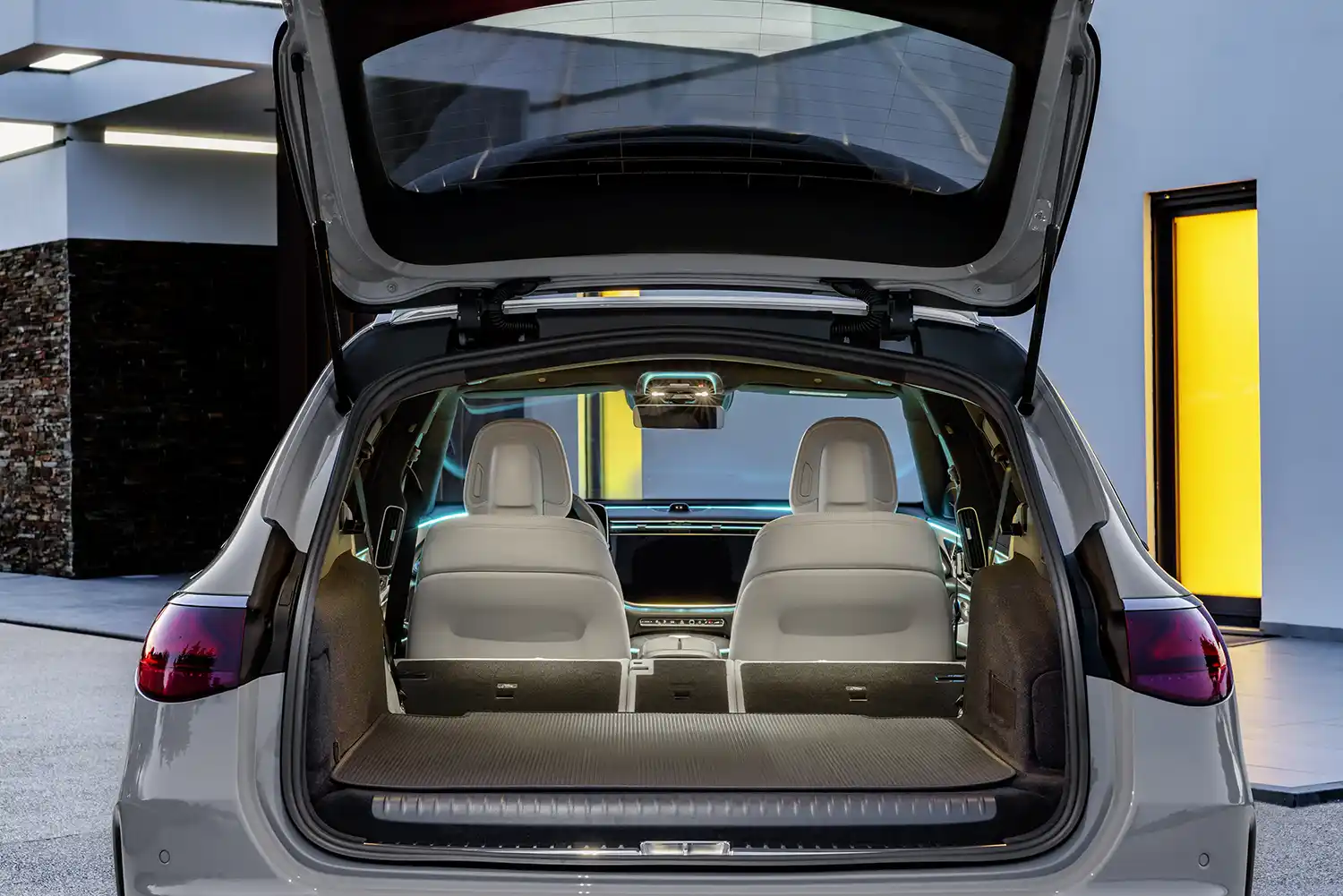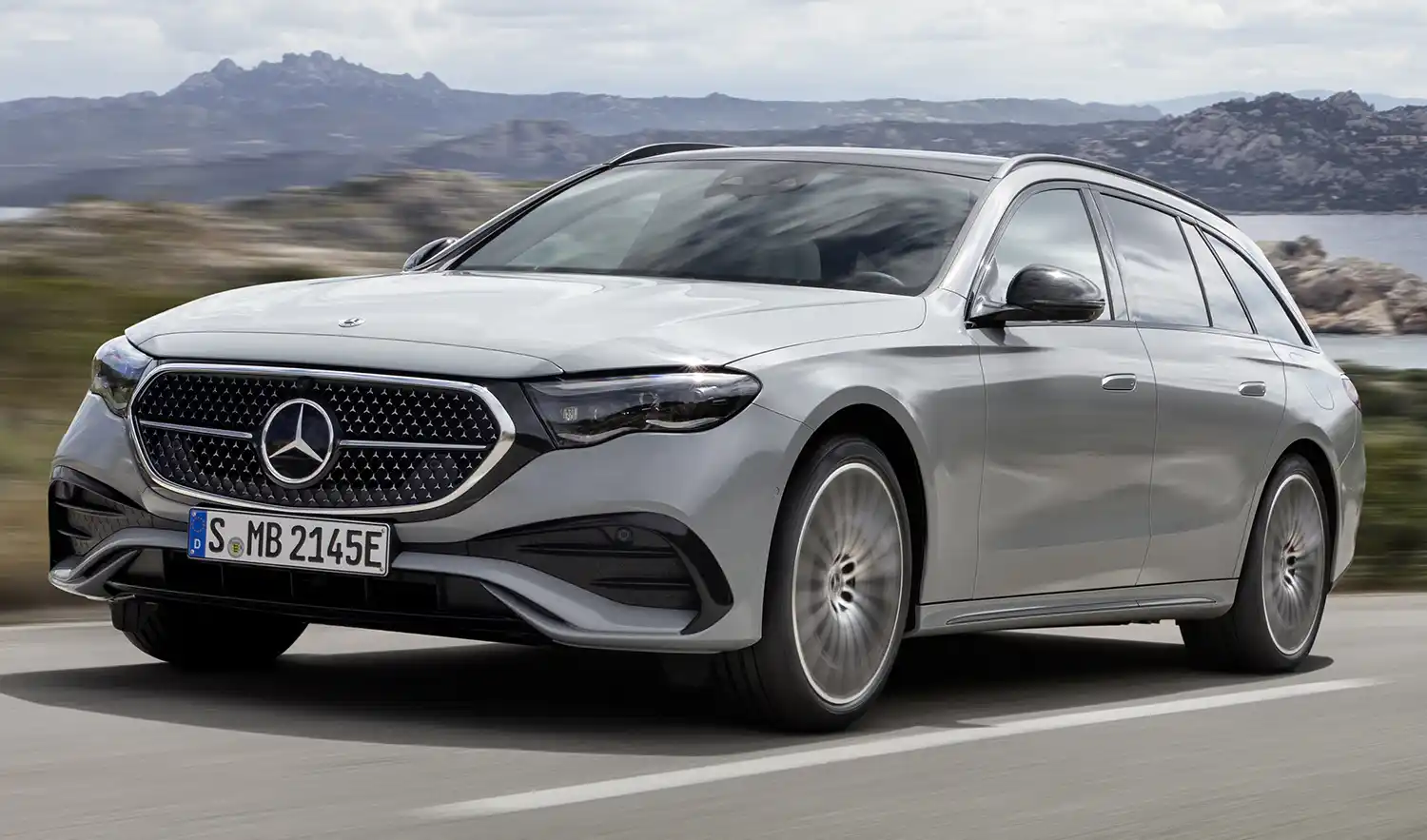
As functional as its predecessor, as intelligent and customisable as never before: The new Mercedes-Benz E-Class Estate, model series 214, impresses in many areas. The design has also changed: The roofline is more dynamically designed compared to its predecessor, and at the same time the new E-Class Estate scores again with functionality and load compartment volume. Combined with the raked rear window, the overall appearance is progressive.
Like the Saloon before it, the Estate not only continues the long model history of the classic E-Class, but also bridges the gap to the avant-garde trendsetters from Mercedes-EQ with its new design. Balanced proportions are part of the appearance of a classic estate car. They are defined by the short front overhang, the long bonnet with powerdomes, the longer wheelbase and the balanced rear overhang.
With its distinctive side profile, the Estate clearly sets itself apart from the competition. The two character lines familiar from the Saloon create a powerfully stretched car body and give the Estate a sporty and stylish appearance. Sophisticated, three-dimensional and optimised down to the last detail, the surface finish exudes elegance.

A black panel-like surface connects the radiator grille with the headlamps. This insert in high-gloss black is visually reminiscent of the Mercedes-EQ models. The three-dimensionally designed radiator grille is either progressive or classic, depending on the equipment line. A chrome-framed radiator grille backlit by optical fibres is optionally available for all lines (Avantgarde, Exclusive and AMG Line). The new E-Class Estate features LED High Performance headlamps as standard. As an optional extra, DIGITAL LIGHT is available without and with a projection function. All headlamp variants offer a distinctive day and night design. As a typical feature of the brand, the daytime running lights take the shape of an eyebrow.
Precisely designed chrome elements as well as the progressively styled, two-part rear lamps characterise the rear-end design. Thanks to its large opening, the load compartment can be used in a variety of ways. The design team has reinterpreted the rear lamps in terms of their contours and inner workings. With great depth of detail and partly animated functions, the interior design contributes to the vehicle’s high value appeal. The unique star motif makes the day and night design of the rear lamps unmistakable. The two light sections in the side wall and boot lid are visually connected. This further emphasises the width of the rear. The reflectors have been relocated to the bumper. Because this allowed the load compartment opening to be particularly large, this increases the utility value on the one hand and makes the rear view look even wider on the other.
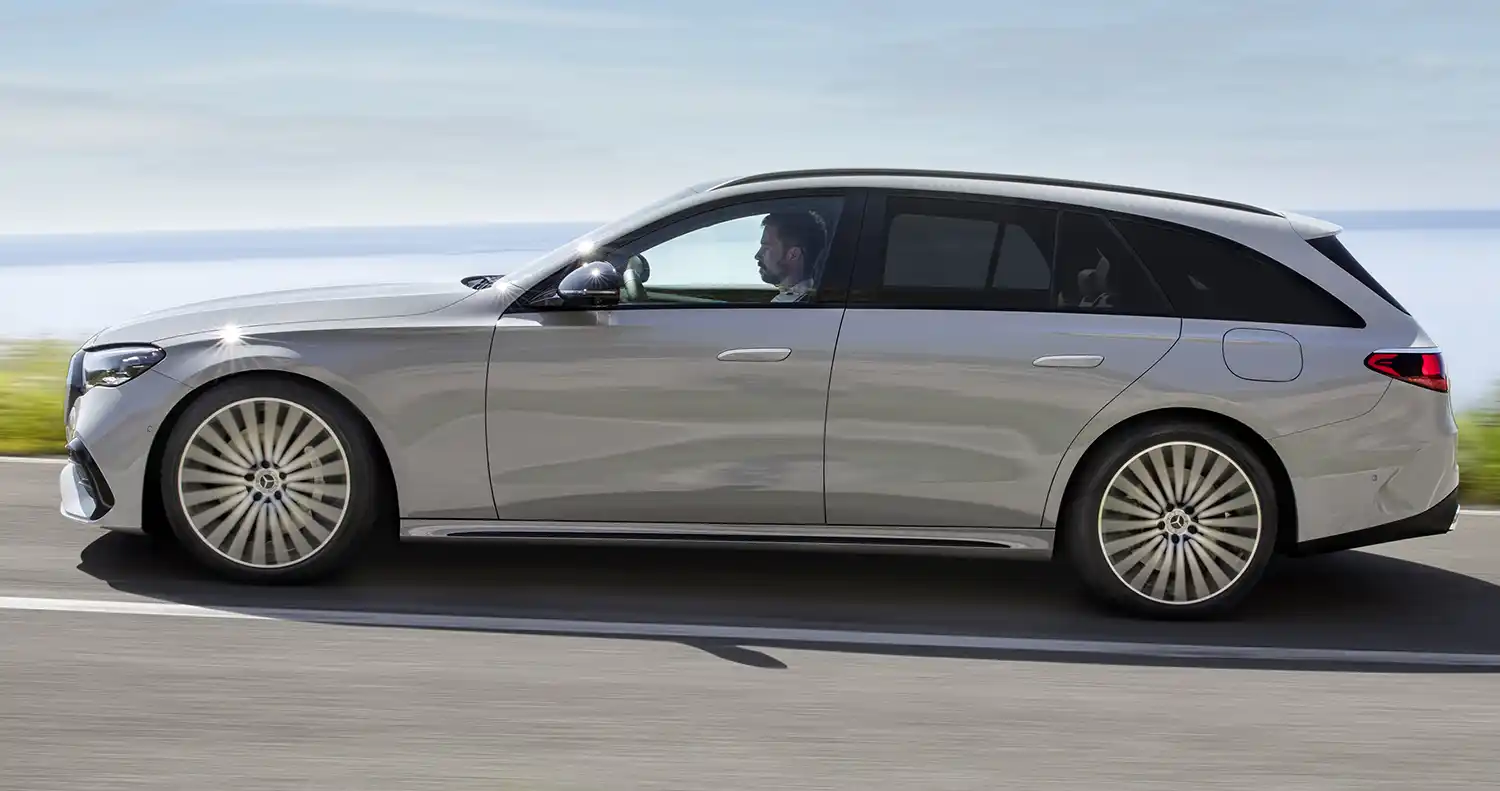
Even more spacious in the rear and the familiar high utility value
Compared to its predecessor, the Mercedes-Benz E-Class Estate has increased in width by 28 millimetres. This gives the rear passengers even more space: The elbow room in the rear is 1519 millimetres – 25 millimetres more than before. The wheelbase has increased by 22 millimetres to 2961 millimetres. As a result, rear-seat passengers enjoy more knee room (84 millimetres; plus 9 millimetres) and leg room (934 millimetres; plus 15 millimetres). The load compartment can be expanded from 615 litres to up to 1830 litres. In the plug-in hybrid model, the luggage capacity is 460-1675 litres, and the load compartment is level there, too.
The seat backrests can be split and folded down in a 40:20:40 ratio. Operation is by two push buttons on the left and right side of the rear seat backrest. The Estate model features the EASY-PACK tailgate as standard. The tailgate opens and closes conveniently at the touch of a button: using the button on the ignition key, the switch in the driver’s door or the release handle on the tailgate. The retractable luggage cover and dividing net (both standard) have a two-piece design. Each has its own roller cassette.
MBUX Superscreen as a highlight of the interior design
The dashboard makes for the digital experience in the interior. If the E-Class Estate is equipped with the optional front passenger screen, the large glass surface of the MBUX Superscreen extends to the central display. Visually detached from this is the driver’s display in the driver’s field of vision. The models without a passenger display feature a large trim element that extends to the centre. Visually detached, the central display appears to float above the concave surface of this trim element.

The front section of the instrument panel is illuminated by the light strip of the Active Ambient Lighting. This runs in a wide arc from the windscreen, past the A-pillars and into the doors. This creates a generous feeling of space. An apparently free-floating control array in the upper section of the door panels matches the look of the glass surfaces of the screens.
The centre console is designed as a homogeneous unit and merges in a straight line into the lower section of the dashboard. At the front, a stowage compartment with lid and cup holders is integrated into the three-dimensionally shaped trim element. There is a soft padded armrest in the rear part of the centre console.
The door centre panel merges seamlessly into the armrest with a concave sweep. The front section here is designed as a metallic high-tech element. It serves as a grab and closing handle, and incorporates the switches for the power windows. Another highlight is the free-floating control array incorporating the door opener and the controls for the seat functions.
The contours of the seat surface and backrest flow elegantly from the inside to the outside, and appear to float above the base of the seat thanks to their layer design. Indented vertical lines follow the outer contour, widening out towards the top.
A plug-in hybrid is already available at launch
Thanks to systematic electrification and intelligent downsizing, the new E-Class sets new standards in efficiency. The combustion engines are four and six-cylinder units from the current modular Mercedes-Benz engine family FAME (Family of Modular Engines). Accordingly, the engine range plays a major role in the flexibility of the international production network, with needs-based electrification.
In addition to turbocharging, both the diesel and petrol engines feature intelligent support from an Integrated Starter-Generator (ISG). They are therefore mild hybrids. Thanks to a new battery, the power of the electric motor has been increased from 15 to 17 kW and the boost torque to 205 Nm. Further mild hybrid models will follow.
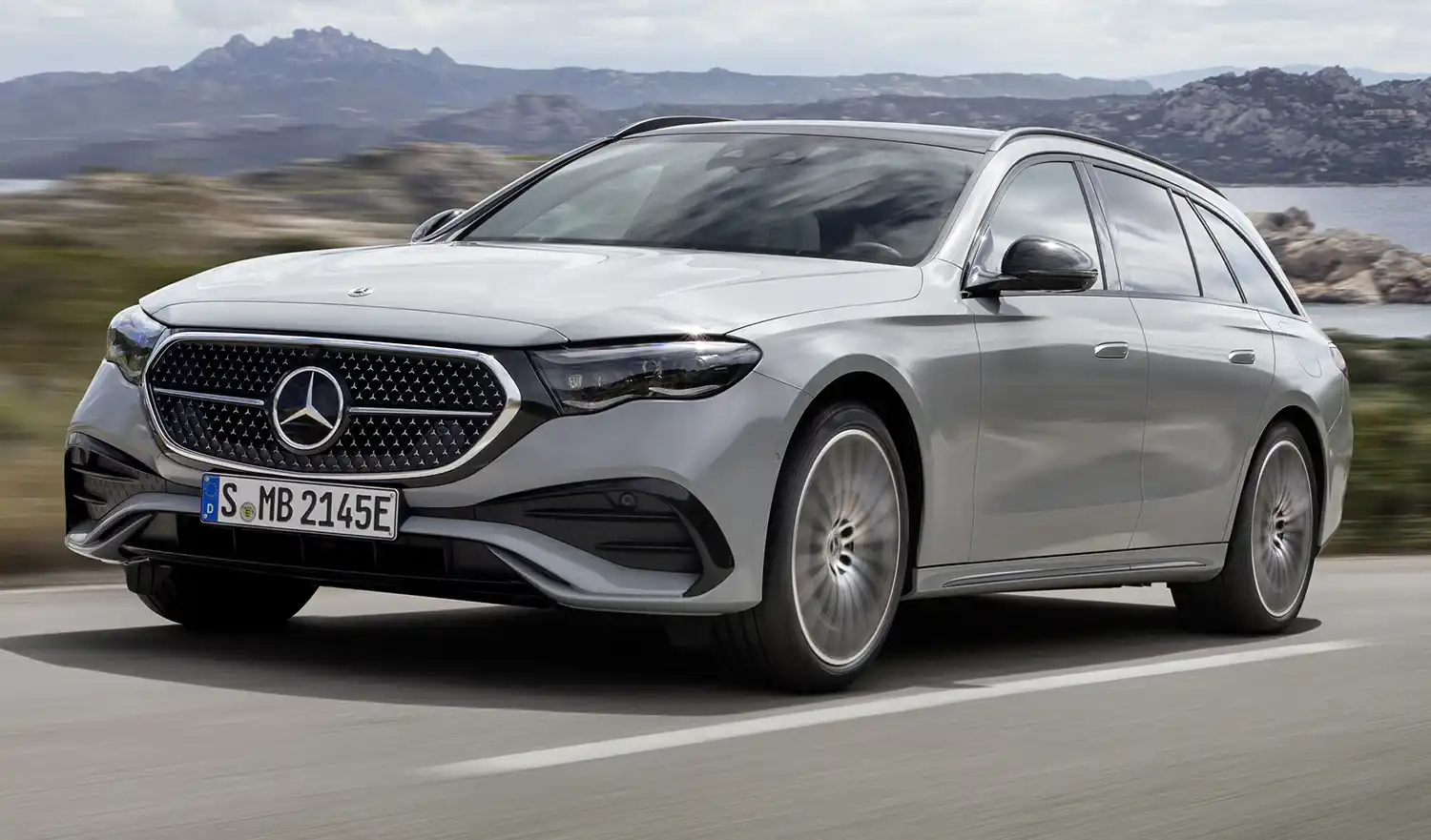
With the E300e a plug-in hybrid is also available at market launch already. With an electric output of 95 kW (129 hp) and an all-electric range of up to over 100 kilometres (WLTP), this model will on many days be on the road purely electrically, without the use of the petrol engine. More plug-in hybrids with diesel combustion engines will follow.
Air-sprung rear axle as standard, AIRMATIC available as an option
The agile handling of the new Mercedes-Benz E-Class Estate is due in large part to precise guidance of the front wheels by four control arms each. At the rear axle, an optimised multi-link independent rear suspension with five links ensures excellent wheel control and excellent straight-line stability. At both axles, the springs and dampers are combined in a single strut and are not involved in wheel guidance tasks, therefore the suspension responds with corresponding sensitivity. The front subframe and rear axle carrier decouple the suspension and body from vibrations and noise. As standard, the mild hybrid models are equipped with AGILITY CONTROL steel spring suspension with selective damping system and air-sprung rear axle.
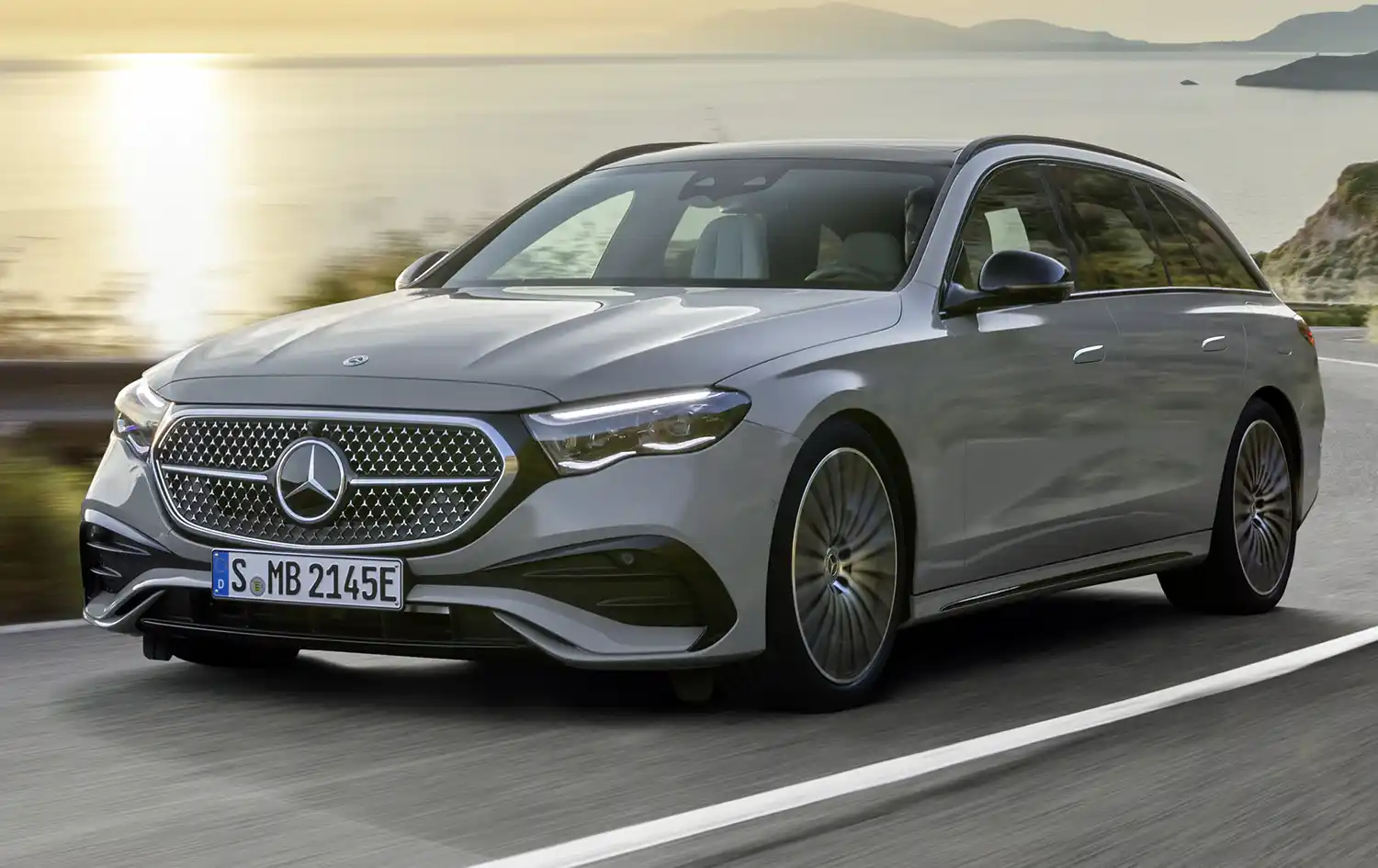
As an option, the new E-Class is available with all-round AIRMATIC air suspension with ADS+ continuously adjustable damping. The AIRMATIC suspension with air springs and adaptive ADS+ dampers responds very sensitively. The all-round level control is another feature of AIRMATIC. It keeps the ground clearance constant irrespective of the vehicle load, but also makes changes when needed.
Impressive, immersive entertainment experience
Music, games and streaming content can be experienced with almost all senses in the E-Class Estate. Thanks to digital innovations in the interior, the E-Class is now more intelligent, achieving a new dimension of personalisation and interaction. At the same time, the electronic architecture is more software-driven and less hardware-driven.
The computing functions of previously separate domains take place in a single processor. Screens and the MBUX infotainment system thus share a new, very powerful central onboard computer. This form of networking improves the performance and speed of the data streams.
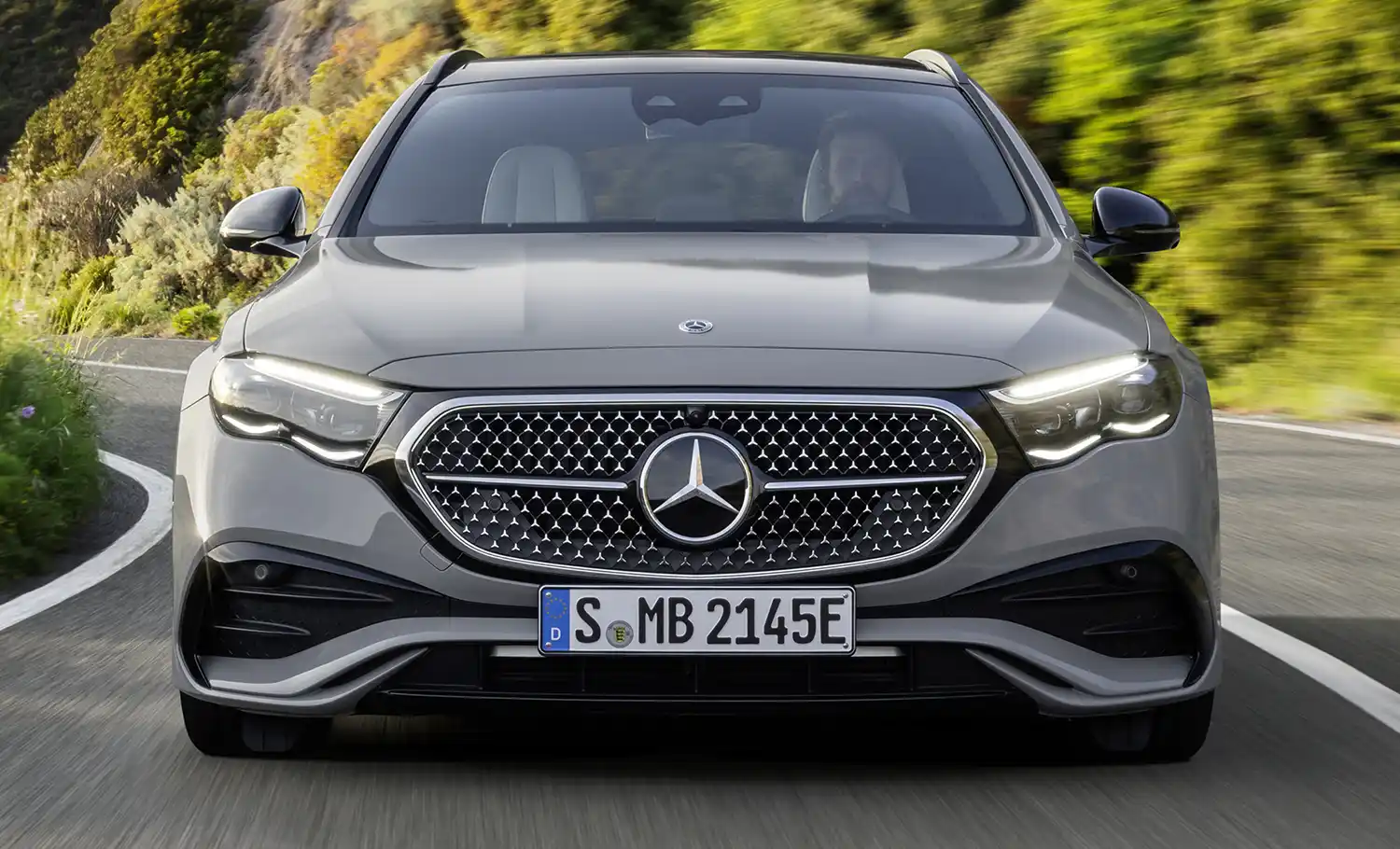
The Entertainment Package (MBUX Entertainment Plus) will be available for the new E-Class Estate. It includes Mercedes me connect services and a data package from a third-party provider. Depending on the market, a communication module with 5G as the transmission technology is used. The mobile phone standard 5G makes much faster data rates possible than LTE/UMTS.
The Digital Vehicle Key is now available for the iPhone and Apple Watch
With the Digital Vehicle Key, the Mercedes-Benz E-Class Estate can be started and locked simply by the driver carrying a compatible device with them. Key sharing is also possible: Various digital channels can be used to invite family members or friends to use the E-Class Estate. In doing so, the vehicle owner can assign different rights, granting only access to the vehicle or also allowing it to be driven. The vehicle can recognise several users at once, and the Digital Vehicle Key can be shared by up to 16 persons. In those markets where Mercedes me connect services are available, the pre-installation for the Digital Vehicle Key forms part of the KEYLESS GO Comfort Package. This equipment combination is available in the new E-Class Estate from the Premium Package onwards.
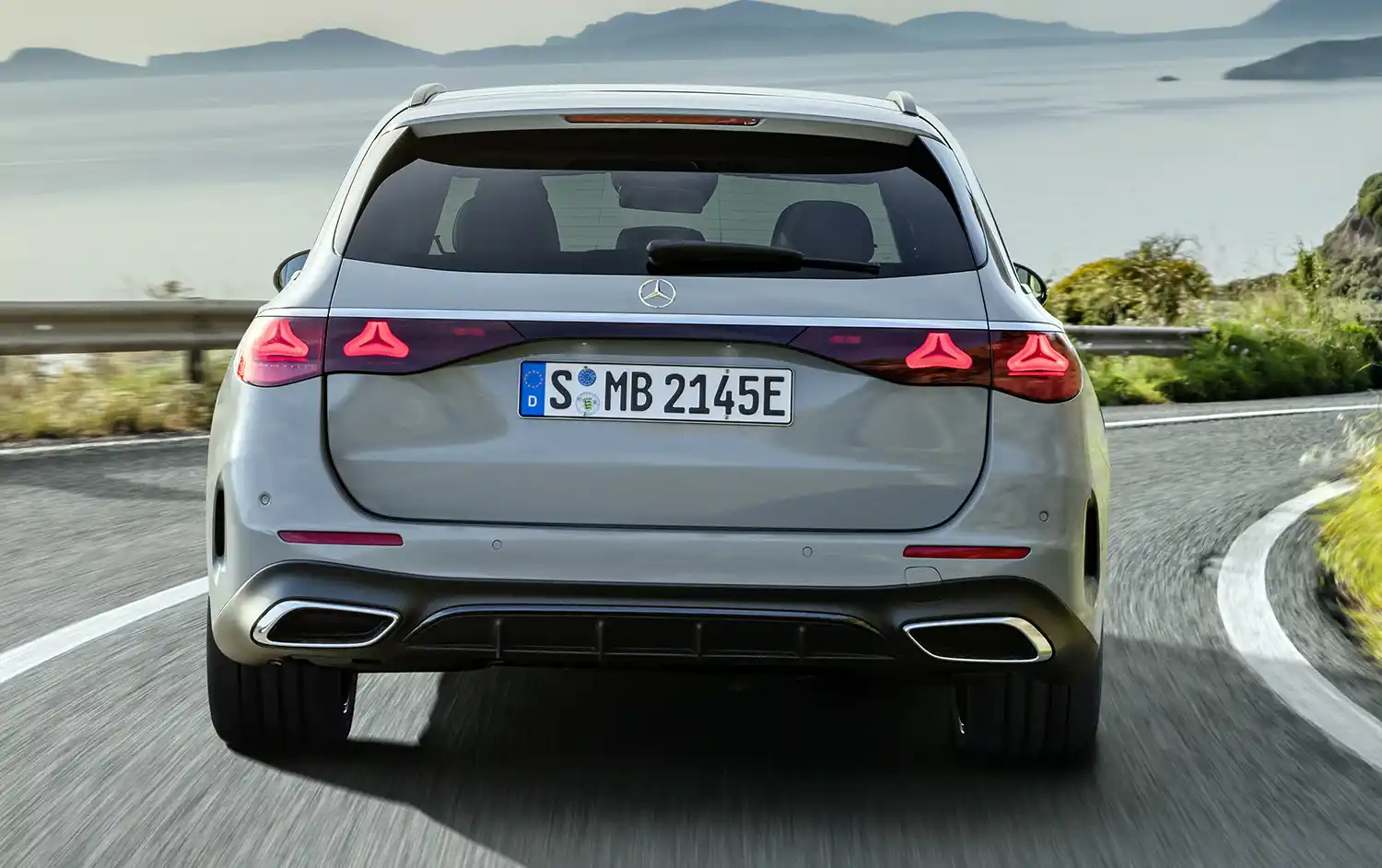
Music becomes visible: Sound Visualisation
With the new Active Ambient Lighting with Sound Visualisation, occupants in the new E-Class Estate can experience music with three senses: pieces of music and sounds from films or apps can be heard (with Dolby Atmos® technology if desired), felt (by means of sound resonating transducers in the optional Burmester® 4D surround sound system) and now also “seen”. Visualisation takes place on the light strip of the Active Ambient Lighting (optional extra). For the first time, this applies throughout in the E-Class. For example, fast sequences of beats can cause rapid light changes, while flowing rhythms can create softly merging lighting moods.
The entertainment experience for the front passenger is always impressive. On their optional screen, the front passenger can watch dynamic content such as TV or video streaming even when the driver at the wheel is looking over at them. This is because the display is switchable. The advanced camera-based privacy function automatically reduces its brightness and therefore the risk of driver distraction.
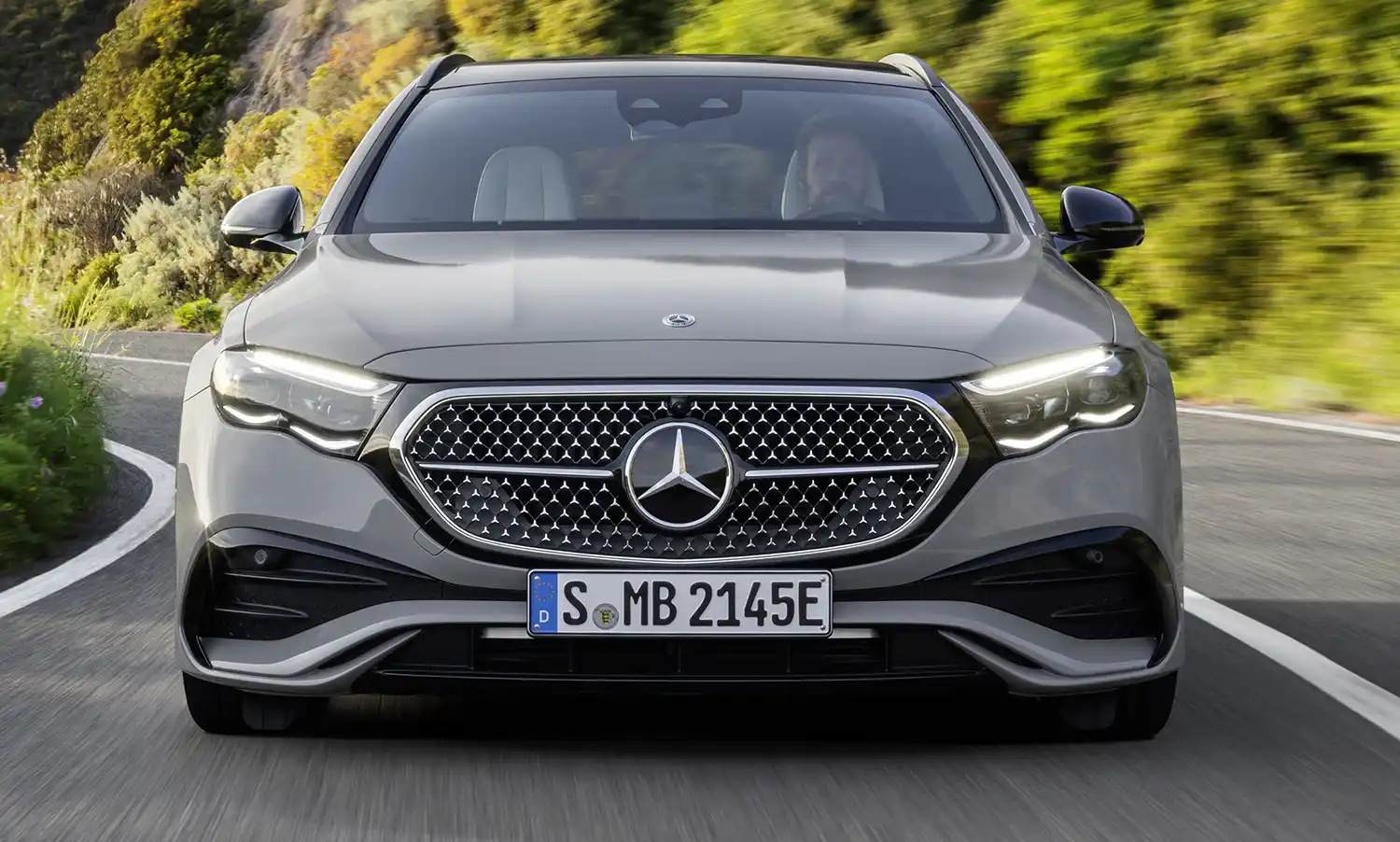
New third-party apps plus selfie and video camera
The software experts at Mercedes-Benz have developed a new compatibility layer that allows the installation of third-party apps. The following apps are available on the central display in the E-Class Estate at market launch: the entertainment platform “TikTok”, the game “Angry Birds”, the collaborative application “Webex” and the office application “Zoom” as well as the browser “Vivaldi” and the podcast app “Pocket Casts”. In addition, the ZYNC entertainment portal (optionally) offers video streaming, on-demand content, interactive experiences, local video programmes, sports, news, games and much more on the central and passenger displays, via one user interface.
Another new feature is a selfie and video camera (part of the optional MBUX Superscreen) on top of the dashboard. When the vehicle is stationary, the driver can participate in online video conferences via e.g. “Webex”, and take personal photos and videos.
More operating convenience is also available with MBUX. With the “Just Talk” function, the intelligent voice control can now be activated without the keyword “Hey Mercedes”. When the function is activated, a red microphone symbol appears in the display. This indicates that the vehicle is ready and waiting for commands.
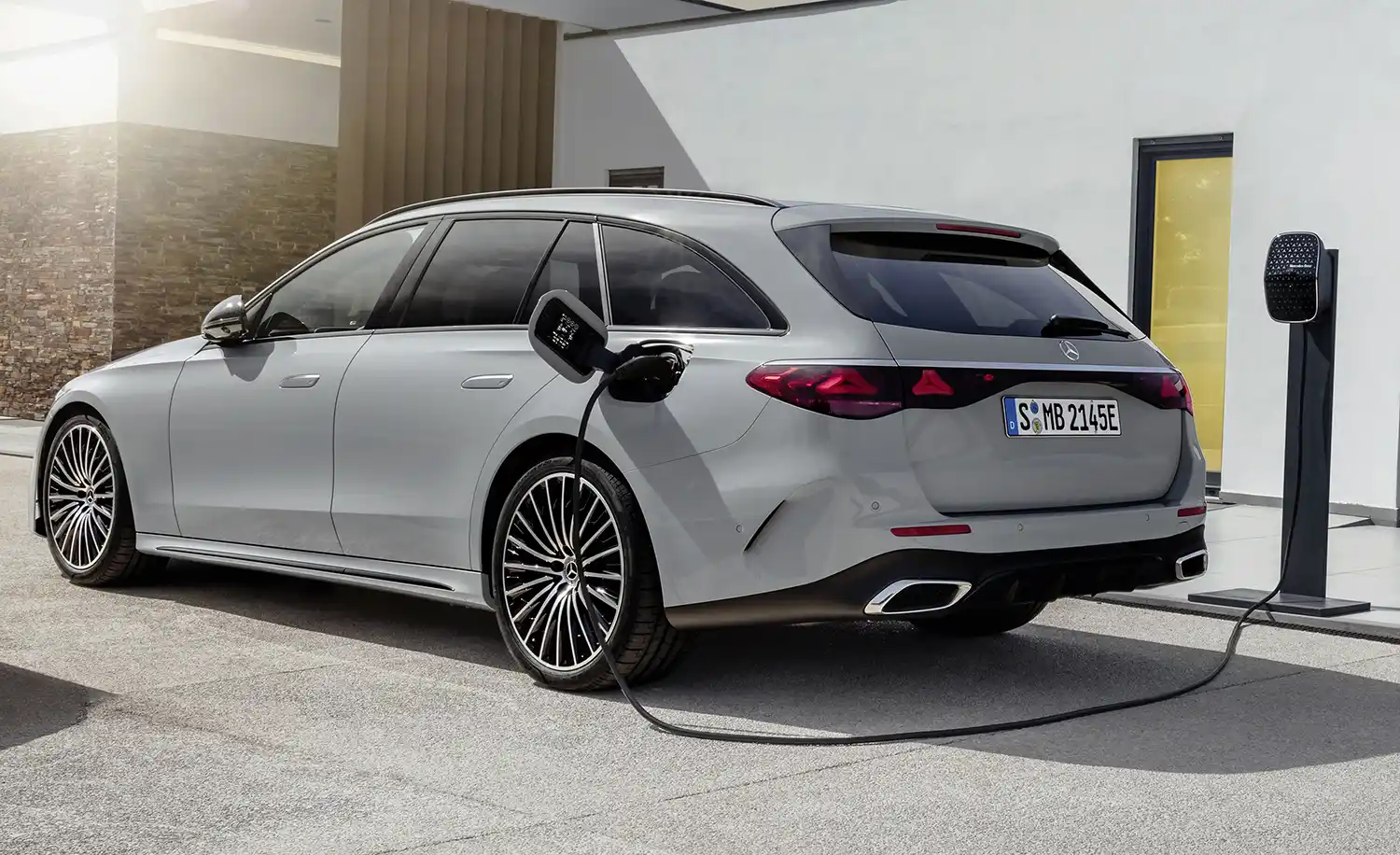
Added day-to-day convenience: the routines
Mercedes-Benz is working on the use of artificial intelligence (AI) so that the car learns which comfort systems vehicle occupants use repeatedly. Given the same circumstances, the aim is for AI to automate such functions. The result is personalised automation. Mercedes-Benz uses the term ‘routine’ for this innovation, the development of which is already well advanced.
When the new Mercedes-Benz E-Class Estate is launched, customers will be able to use templates for standard routines. They also have the option of creating routines themselves. In doing so, the occupants can link several functions and conditions. For example, “Switch on the seat heating and set the ambient lighting to warm orange if the interior temperature is below twelve degrees Celsius”.
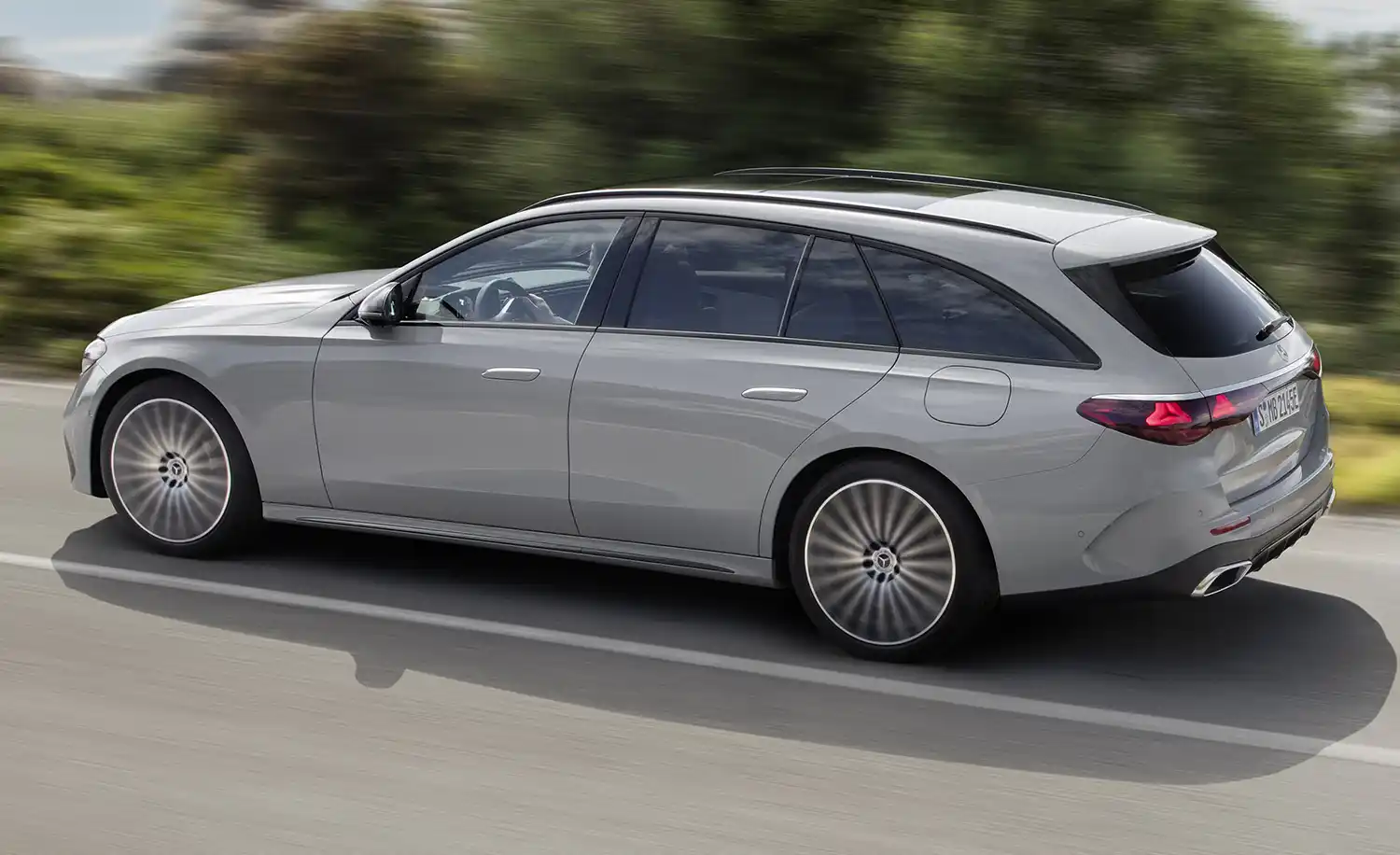
For enhanced well-being: ENERGIZING COMFORT and THERMOTRONIC with Digital Vent Control (both optional)
Soothing sounds, mobilising massage, activating light – Mercedes-Benz offers a comprehensive wellness programme with the variously configured ENERGIZING COMFORT programmes and the individual recommendations of the ENERGIZING COACH. The new E-Class generation marks the debut of two innovations: The anti-travel sickness programme of ENERGIZING COMFORT can help affected passengers to alleviate symptoms. A bio-feedback function is planned for the ENERGIZING COACH in the medium term. This can reduce the feeling of stress with breathing exercises.
With THERMOTRONIC automatic climate control (optional extra), Digital Vent Control enhances the comfort experience. It automatically adjusts the front air vents to a desired ventilation scenario. This can be done for each seat via the user profile, for example. However, the nozzles can also be aligned by hand as usual.
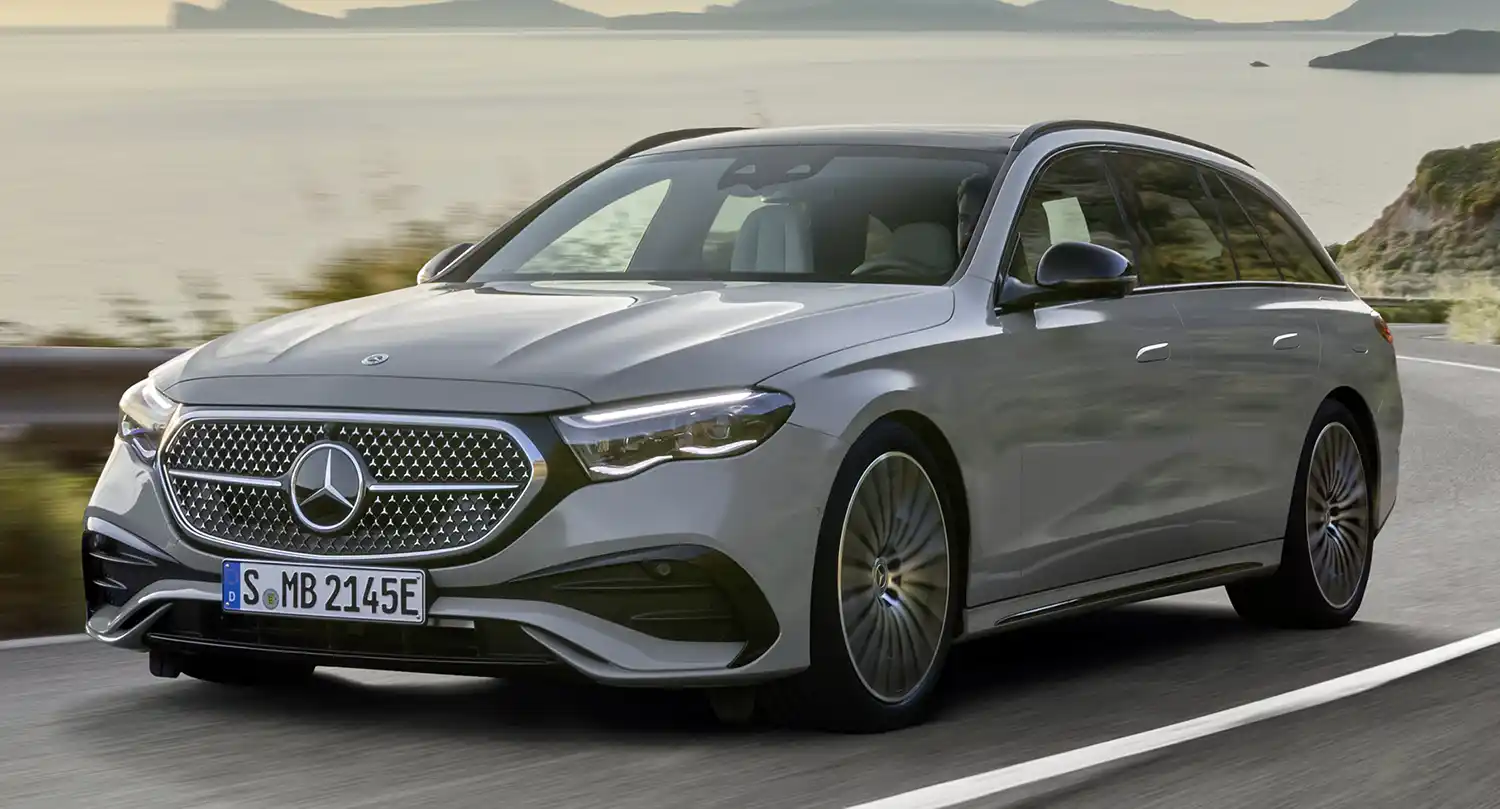
Numerous driving assistance systems, some of which have been developed further
The standard equipment of the E-Class Estate with driving assistance systems includes Active Distance Assist DISTRONIC, ATTENTION ASSIST, Active Brake Assist, Active Lane Keeping Assist, Parking Package with reversing camera and Speed Limit Assist. The status and activity of the driving assistance systems are shown as a full-screen view in the Assistance mode of the driver’s display.
The Driving Assistance Plus package is also offered as an optional extra, for example as part of the Premium package. Components include Active Steering Assist, which assists with lane-keeping. As already on motorways, the E-Class can now also restart automatically in city traffic and on country roads after a longer standstill. Another new feature: If Active Steering Assist is no longer available because the lane markings are not clearly visible, it signals this to the driver by means of vibration on the steering wheel.
Sophisticated body concept and coordinated restraint systems
The safety concept of the E-Class Estate is based on a body with a particularly rigid passenger cell and specifically deformable crash structures. The restraint systems, e.g. seat belts and airbags, are specifically adapted to this. In the event of an accident, they can be activated in such a way that their protective effect for the occupants is adapted to the situation.
In addition to driver and front passenger airbags, a knee airbag on the driver’s side is also standard. It can protect the legs from contact with the steering column or instrument panel in a severe frontal crash. The standard windowbags can reduce the risk of head injuries. In the event of a serious side-on collision, the window airbag on the side of the impact extends from the A- to the C-pillar like a curtain over the front and rear side windows. If a rollover is detected, the window airbags can be activated on both sides. In addition to the head protection system, side airbags can also protect the thorax area in the event of a severe side impact – including on the outer rear seats as an option.
In addition, the vehicles are equipped with a centre airbag, depending on the country. Pyrotechnic belt tensioners and force limiters are standard on all outer seats, as are seat belt adjusters.
Resource-conserving materials
Numerous Mercedes-Benz E-Class Estate components are made partly from resource-saving materials (recyclates and renewable raw materials). Upholstery made of undyed alpaca wool combined with a recycled material is used for the basic seat. For the first time, certified recycled raw materials are used in the foam of the seats according to the “mass balance approach”. These have the same properties as raw materials produced from petroleum. In this way, the need for fossil resources can be reduced while maintaining product quality.
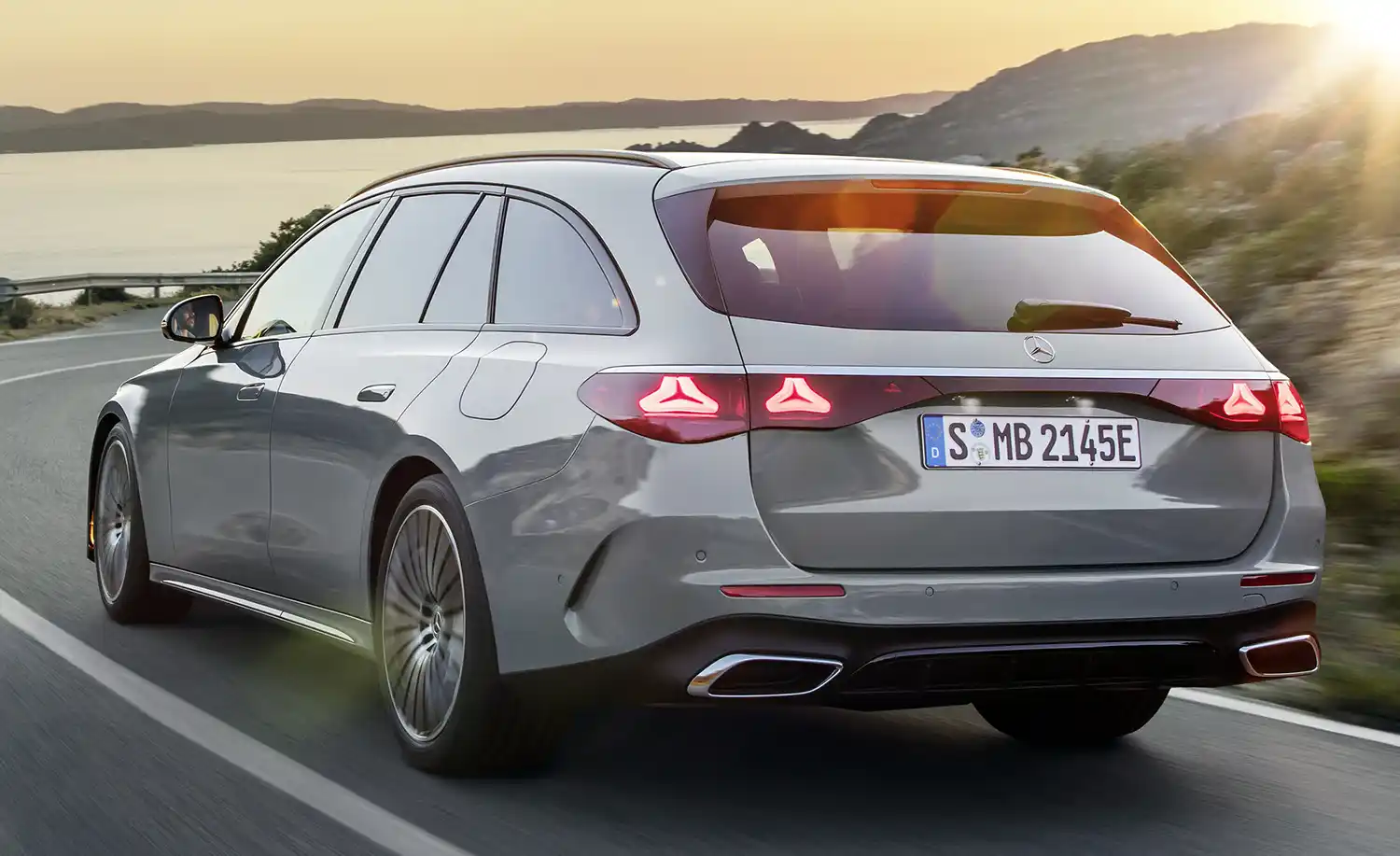
Neutral CO2 balance in production at the Sindelfingen plant
Since 2022, Mercedes-Benz has been producing with a neutral CO2 balance in all of its own plants worldwide. The externally sourced electricity comes exclusively from renewable energies, and is therefore CO2-free. In addition, the company aims to increase the generation of renewable energy at its locations. Investments will be made in a further expansion of photovoltaics at the entire Sindelfingen location by the end of 2024. Another focus at the Sindelfingen location is on constantly reducing water consumption and the amount of waste produced.
The E-Class Estate as a long-standing success story
Mercedes-Benz has produced more than 16 million upper mid-range vehicles since 1946. In August 1966, the Mercedes-Benz Universal made its debut in the official sales programme. It was an estate car built by Belgian partner IMA on the basis of the 200 D to 230 S tail fin versions – the first official Mercedes-Benz estate car.
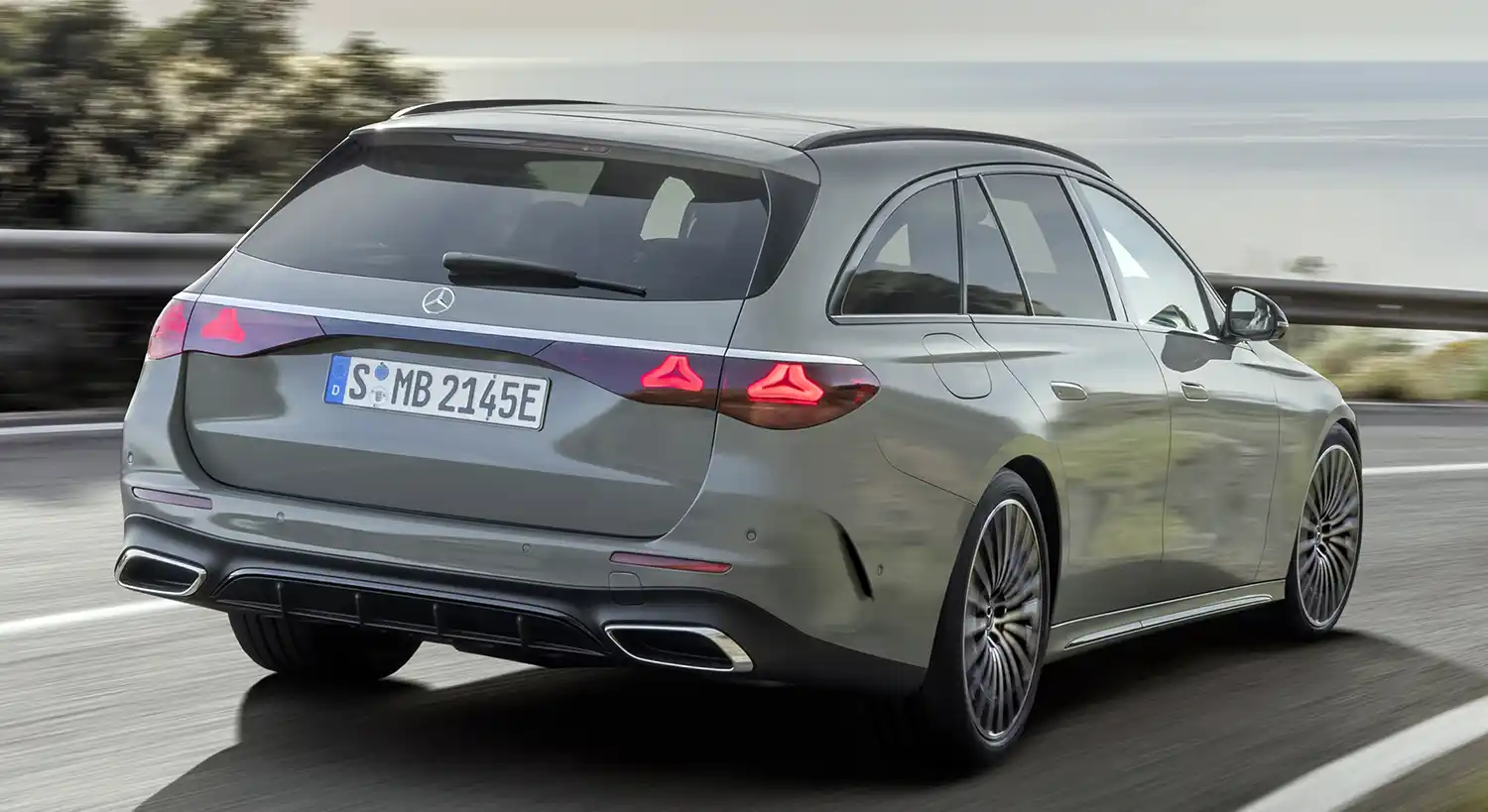
In April 1978, the Estate 123 model series entered production and a long success story began – well over a million estate models have been built to date. In Germany, the Estate is known as the “T-Modell” and although the “T” suggests tourism and transport, it also stands for trendsetter. For Mercedes-Benz, the estate model is now an integral part of the luxury segment and has a loyal fan base, particularly in Germany. There has been an estate in every successive generation of the E-Class (S 124, S 210, S 211, S 212, S 213, as well an All-Terrain version since 2017).
The exterior design
As functional as its predecessor, as intelligent and customisable as never before: The new Mercedes-Benz E-Class Estate, model series 214, impresses in many areas. The design has also changed: The roofline is more dynamically designed compared to its predecessor, and at the same time the new E-Class Estate scores again with functionality and load compartment volume. Combined with the raked rear window, the overall appearance is progressive.
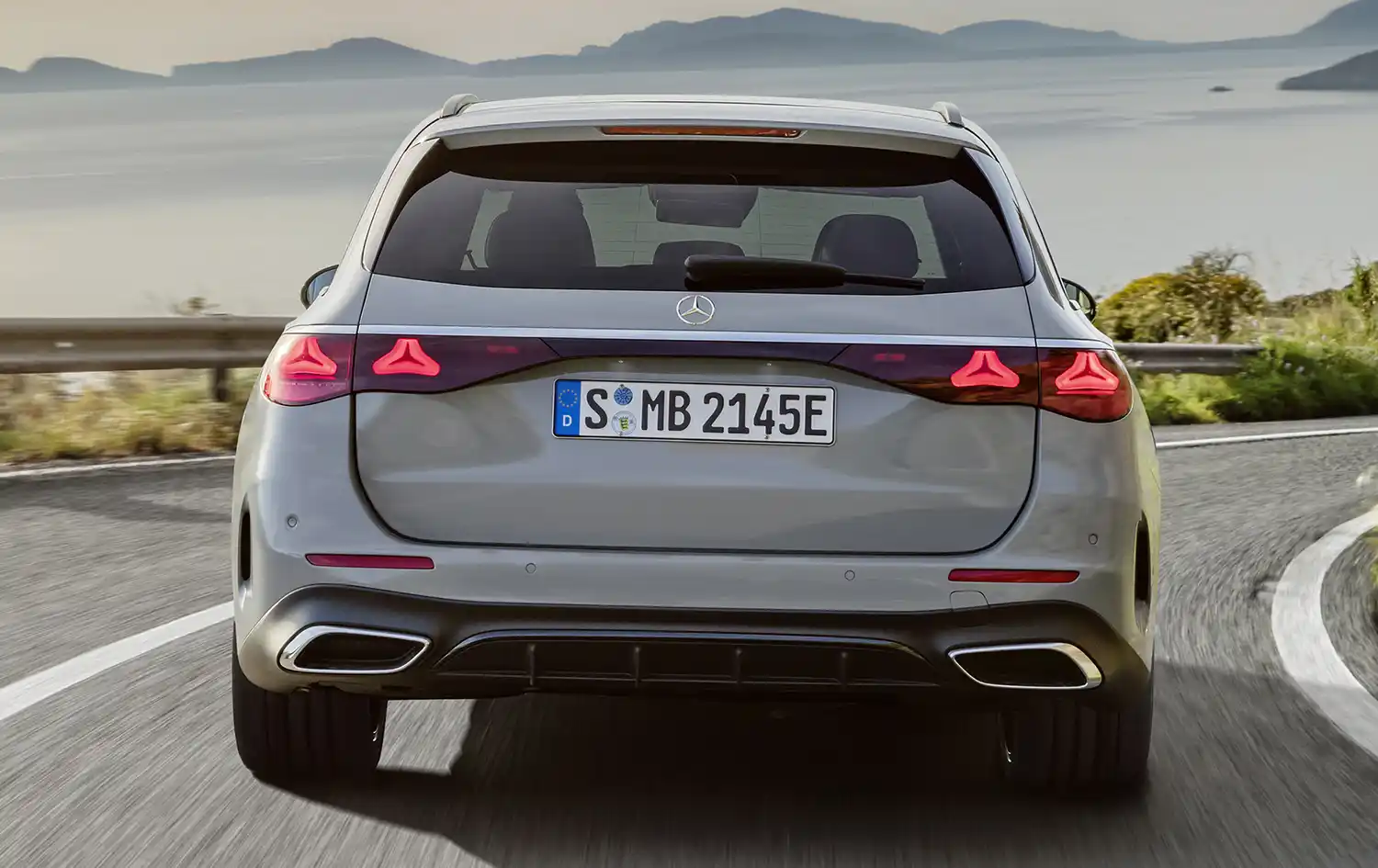
Like the Saloon before it, the Estate not only continues the long model history of the classic E-Class, but also bridges the gap to the avant-garde trendsetters from Mercedes-EQ with its new design. Balanced proportions are part of the appearance of a classic estate car. They are defined by the short front overhang, the long bonnet with powerdomes, the longer wheelbase and the balanced rear overhang.
With its distinctive side profile, the Estate clearly sets itself apart from the competition. The two character lines familiar from the Saloon create a powerfully stretched car body and give the Estate a sporty and stylish appearance. Sophisticated, three-dimensional and optimised down to the last detail, the surface finish exudes elegance. The E-Class Estate is equipped with the flush-fitting door handles familiar from the Mercedes-Benz luxury-class models. They extend electrically when the driver approaches or strokes the outer surface of the door handle. The attached roof rails combine form and utility. Light-alloy wheels with high-quality surfaces and up to 21 inches in size round off the expressive side view.
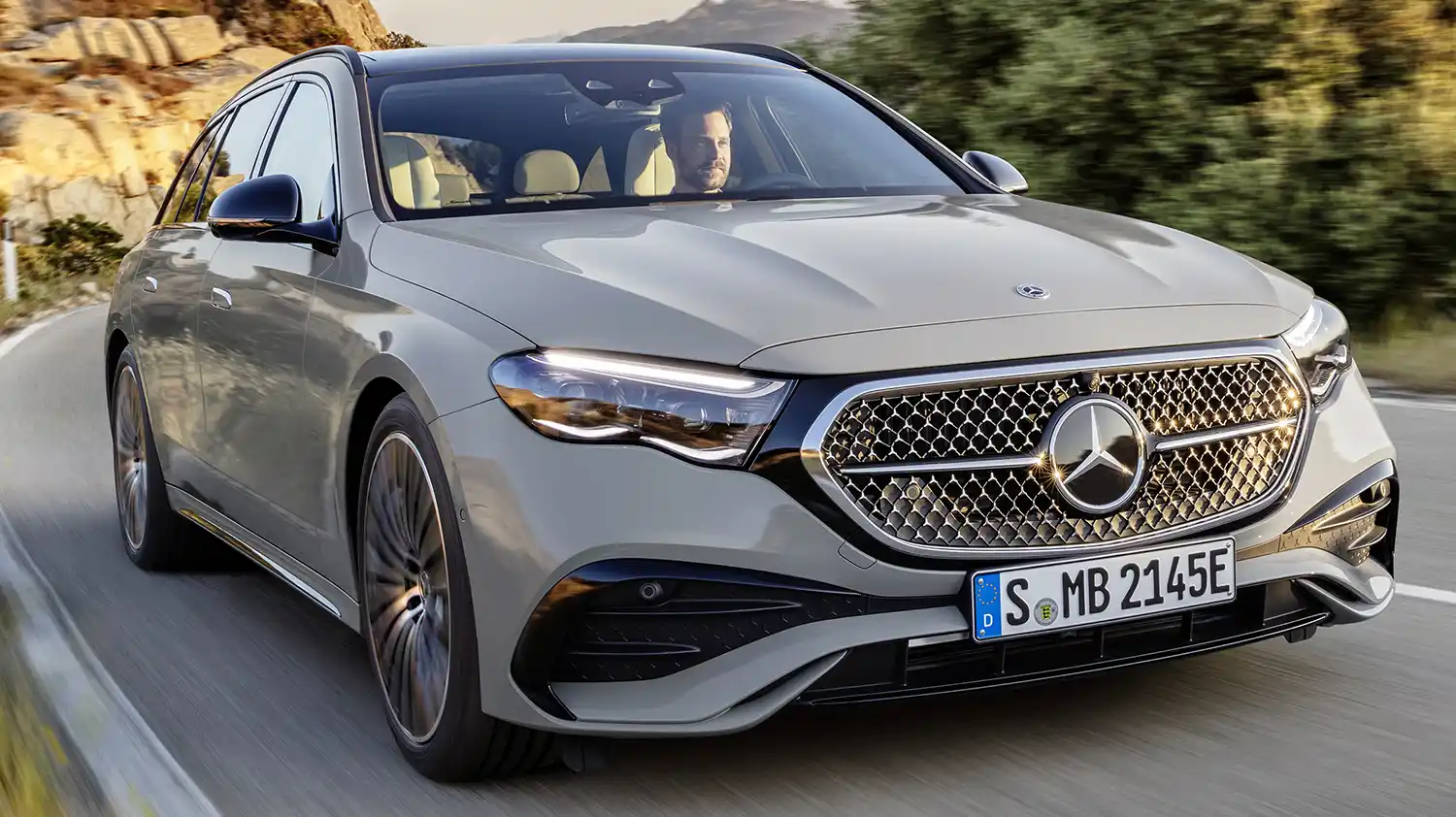
Precisely designed chrome elements as well as the progressively styled, two-part lamps characterise the rear-end design. Thanks to its large opening, the load compartment can be used in a variety of ways. The design team has reinterpreted the rear lamps in terms of their contours and inner workings. With great depth of detail and partly animated functions, the interior design contributes to the vehicle’s high value appeal. The unique star motif makes the day and night design of the rear lamps unmistakable. The two light sections in the side wall and boot lid are visually connected. This further emphasises the width of the rear. The reflectors have been relocated to the bumper. Because this allowed the load compartment opening to be particularly large, this increases the utility value on the one hand and makes the rear view look even wider on the other.
Black-panel-like element at the front and illuminated radiator grille surround
The connection between tradition and modernity is made particularly clear by a feature at the front: A black panel-like surface connects the radiator grille with the headlamps. This insert in high-gloss black is visually reminiscent of the Mercedes-EQ models. The three-dimensionally designed radiator grille is either progressive or classic, depending on the equipment line. In the Avantgarde version, the central star is integrated into the grille. Other design features of this line include a single louvre, grilles in a chrome star motif and chrome surrounds. In the Exclusive version, on the other hand, the radiator grille has three horizontal twin louvres. In addition, this version has an upright star on the bonnet.
An illuminated radiator grille is optionally available for all lines (Avantgarde, Exclusive and AMG Line). It extends the side lights. At night or at dusk, white light is fed into the conductor via four LED modules. The two bundles consist of more than 1000 fine glass fibres. While driving, the radiator frame is illuminated in combination with the low beam. When stationary, the radiator grille adds another level of staging to the Coming Home and Leaving Home scenarios.
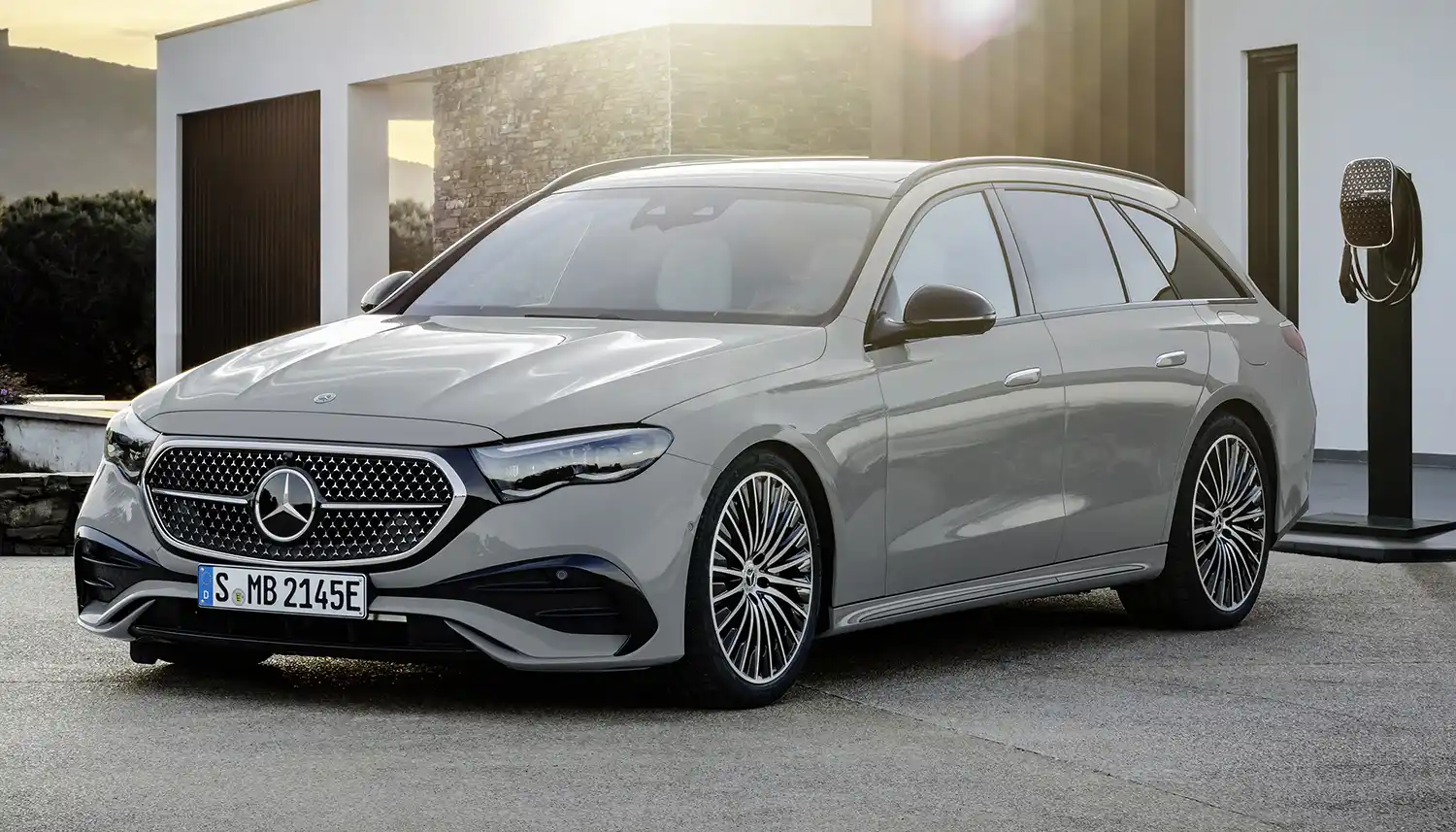
The new E-Class has high-performance LED headlamps as standard. As an optional extra, DIGITAL LIGHT is available without and with a projection function (for further information, see separate chapter). All headlamps offer a distinctive day and night design. As a typical feature of the brand, the daytime running lights take the shape of an eyebrow.
The interior design
The dashboard makes for the digital experience in the interior. If the Mercedes-Benz E-Class Estate is equipped with the optional front passenger screen, the large glass surface of the MBUX Superscreen extends to the central display. Visually detached from this is the high-resolution driver display in the driver’s field of vision.
The contour of the cover glass is dynamic in design. For the central display, the glass surface is extended downwards accordingly. The profile becomes flat towards the outer edges. A narrow nozzle band nestles against the upper contour of the glass surface, connecting the central nozzle with the outer nozzles to form a single unit.
The models without a passenger display feature a large trim element that extends to the centre. Visually detached, the central display appears to float above the concave surface of this trim element.
The front section of the instrument panel is illuminated by the light strip of the Active Ambient Lighting. This runs in a wide arc from the windscreen, past the A-pillars and into the doors, so creating a spacious feeling in the way the door panels merge with the collar of the instrument panel to form a single unit. An apparently free-floating control array in the upper section of the door panels matches the look of the glass surfaces of the screens.
The centre console is designed as a homogeneous unit and merges in a straight line into the lower section of the dashboard. At the front, a stowage compartment with lid and cup holders is integrated into the three-dimensionally shaped trim element. There is a soft padded armrest in the rear part of the centre console. USB ports are located in the compartment below.
The door centre panel merges seamlessly into the armrest with a concave sweep. The front section here is designed as a metallic high-tech element. It serves as a grab and closing handle, and incorporates the switches for the power windows. Another highlight is the free-floating control array incorporating the door opener and the controls for the seat functions.
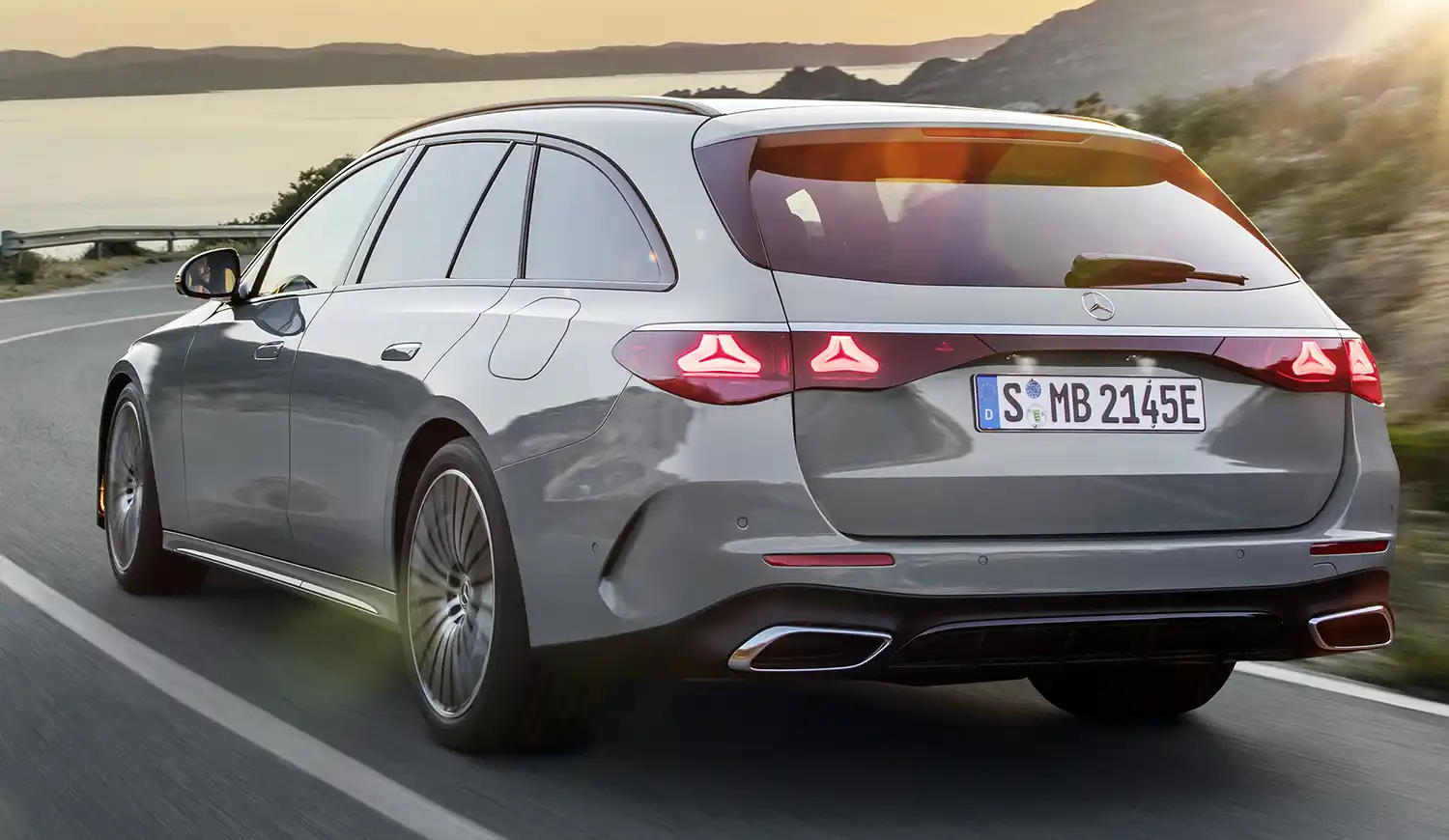
The contours of the seat surface and backrest flow elegantly from the inside to the outside, and appear to float above the base of the seat thanks to their layer design. Indented vertical lines follow the outer contour, widening out towards the top. The association made here by the interior designers was with the organic beauty of shells. If the customer opts for leather upholstery, the seats are designed with elaborate longitudinal fluting, created in individual panels. The nappa leather seats feature quilted and perforated diamond patterns that follow the shape of the seat. The seat with MICROCUT offered as part of AMG Line interior is also perforated.
Extensive range of interior colours and decorative trim
The colour & trim concept conveys a technoid character. E-Class Estate buyers can choose between numerous interior colour combinations. The palette ranges from light beige combined with space grey, including a classy pearl effect, to the sophisticated tonka brown and the cool and technical-looking grey.
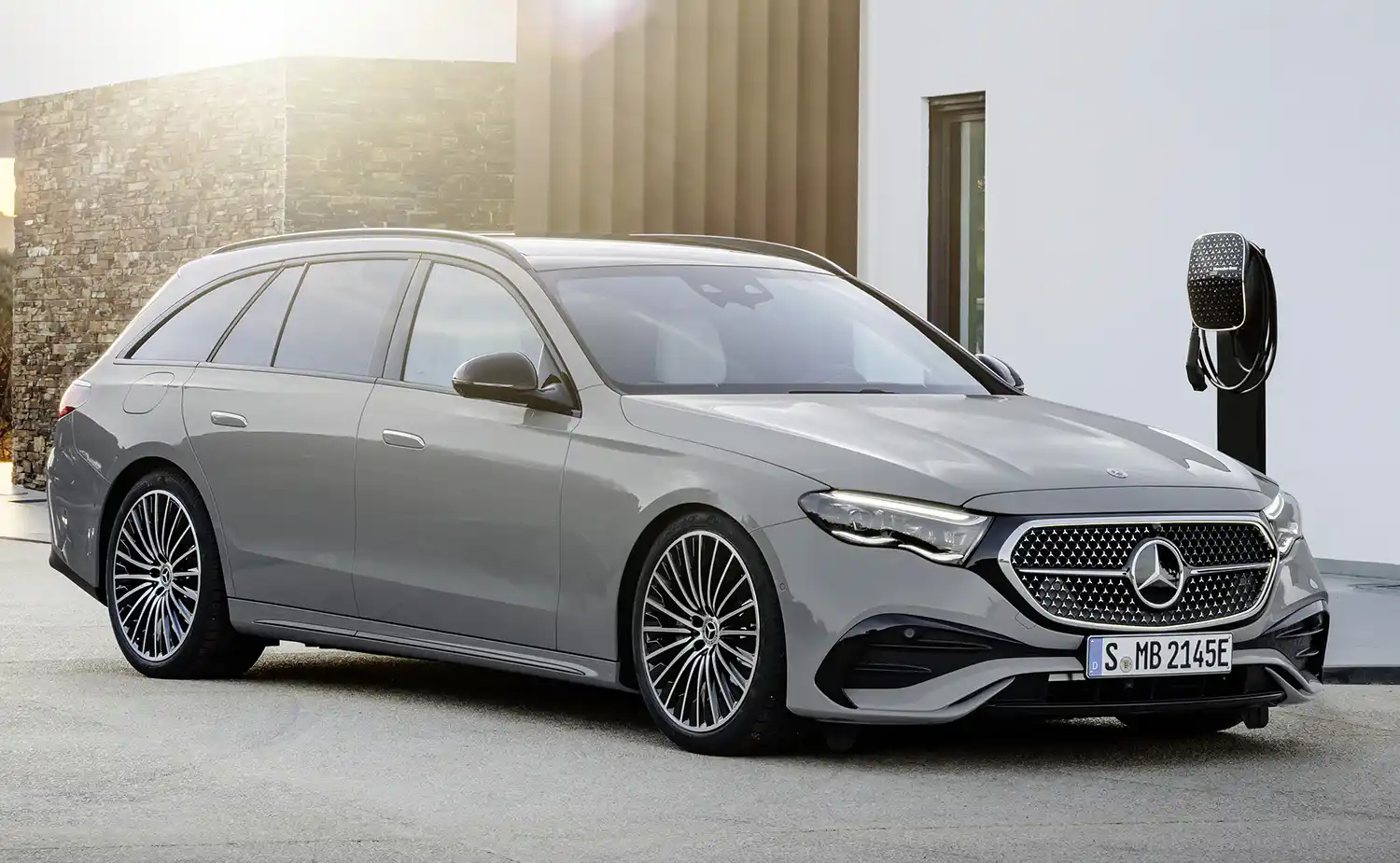
The interior surfaces have a new fine-grain finish from the base trim level upwards, underlining the contemporary character. The interplay between analogue and digital sensory experience is further exemplified by the wide range of trims with innovative, natural or technoid surfaces. Exclusive to the E-Class is interior trim of open-pore wood – dark ash – which is backlit by the Mercedes-Benz pattern.
In addition to other trim panels featuring open-pore woods, the “MANUFAKTUR piano lacquer black flowing lines” variant familiar from the S-Class is also available. Another highlight is interior trim in a silver-coloured metal-mix material. Its high-gloss finish gives it a very futuristic look.
Customisable UI design
The main icons on the central and optional passenger displays are now more clearly displayed, and also colour-coded to match smartphone tiles. This enables the driver to recognise them even more intuitively.

With two display styles (Classic and Sporty) and three modes (Navigation, Assistance, Service), the graphics of the screens can be individualised. In the “Classic” style, the driver is greeted by the familiar display layout with the look of two dial instruments. Varying content with vehicle-related information is displayed between the two tubes.
The “Sporty” style is dominated by the colour red, with a dynamically designed central rev counter. A holistically impressive colour experience is created in the interior by the optional seven colour themes of the ambient lighting.
DIGITAL LIGHT
The new Mercedes-Benz E-Class Estate features LED High Performance headlamps including Adaptive Highbeam Assist as standard. DIGITAL LIGHT and DIGITAL LIGHT with projection function are available as optional extras. Each headlamp contains a module with three extremely powerful LEDs whose light is refracted and directed by 1.3 million micro-mirrors. The micro-mirrors occupy the area of a thumbnail. A control unit with a powerful graphic processor uses an HDMI-like connection to generate a continuous video stream to the mirrors.
The beam, divided into 1.3 million pixels, makes absolutely precise light distribution possible. Highbeam Assist Plus is highly accurate when masking out oncoming traffic or traffic signs. The light-dark boundaries and the light distribution for all other adaptive light functions are also displayed very precisely with DIGITAL LIGHT. This optimises the illumination of fog, motorway or city lights, for example. Based on data from the navigation maps, the topographic light takes driving up and down hills into account, especially crests and dips. For example, when driving over crests, the dazzling of oncoming traffic is reduced by early lowering of the light cone. When driving through dips in the road, the light cone can be raised to obtain the desired light range.
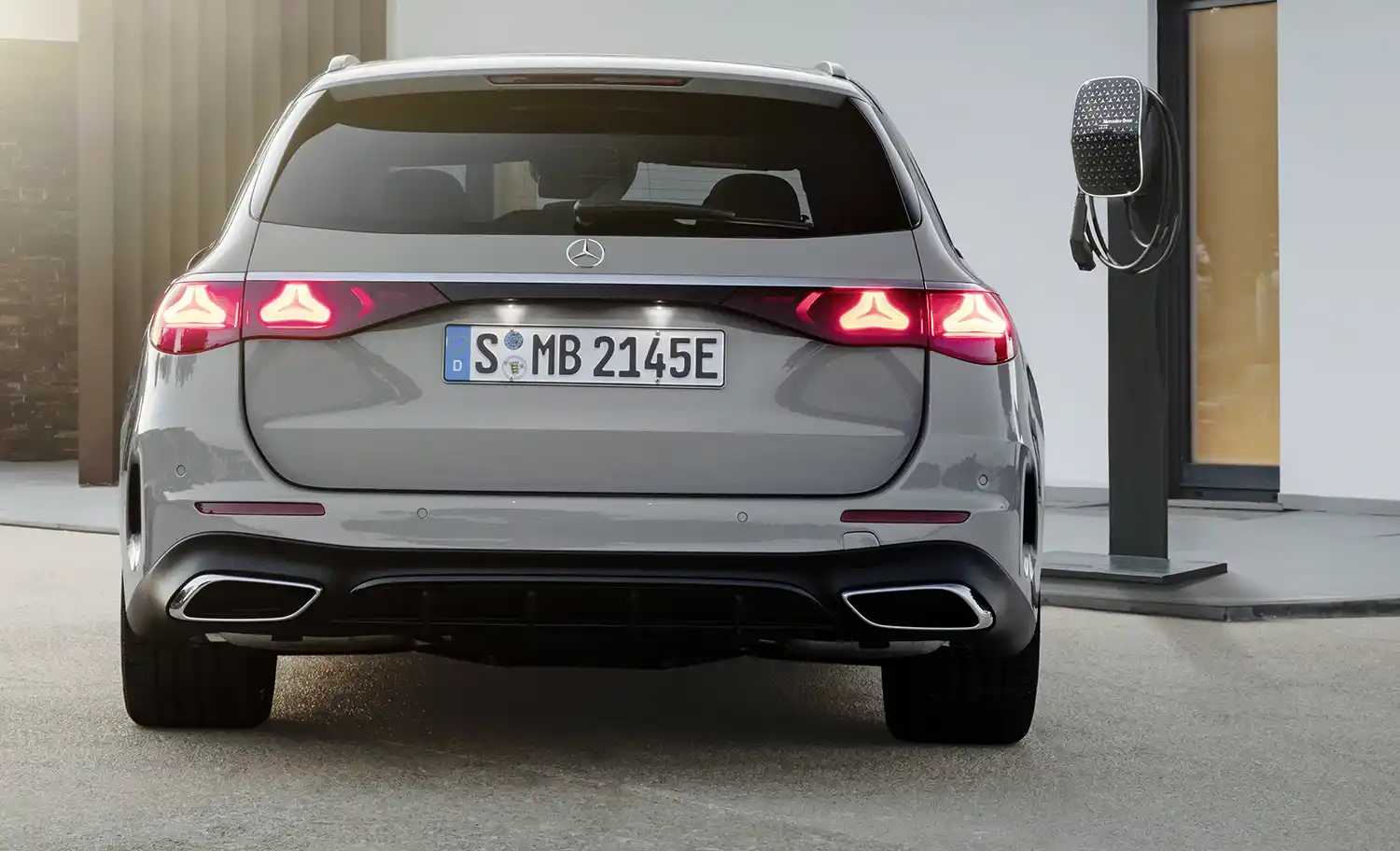
If the E-Class Estate is equipped with DIGITAL LIGHT, DIGITAL LIGHT with projection function can also be subsequently activated as an on-demand feature via the Mercedes me Store. The system also includes these assistance functions:
- Guiding lines: Assistance on narrow road lanes at roadworks by projecting dynamic markings onto the road surface
- Wrong way warning: No-entry sign indicated by projection of a warning symbol onto the roadway
- Lane departure warning and directional guidance: when Lane Keeping Assist detects a hazard
Starting with the new E-Class, Mercedes-Benz has redesigned these warning symbols so that drivers can recognise them even more intuitively on the road.
DIGITAL LIGHT with projection function also communicates with the driver. When the vehicle is unlocked or locked, or when the engine is switched off, the headlamps and tail lamps react with a short light show. The animation function can be switched on and off via MBUX. The “Digital Rain” and “Star Wave” projections are available at market launch.
With the DIGITAL LIGHT Custom Animations, individual welcome and goodbye animations will be possible. This will also include market-specific and seasonal animations, for example at Thanksgiving in the USA. The general and seasonal animations, stored in the back end, are selectable in the Mercedes me App.
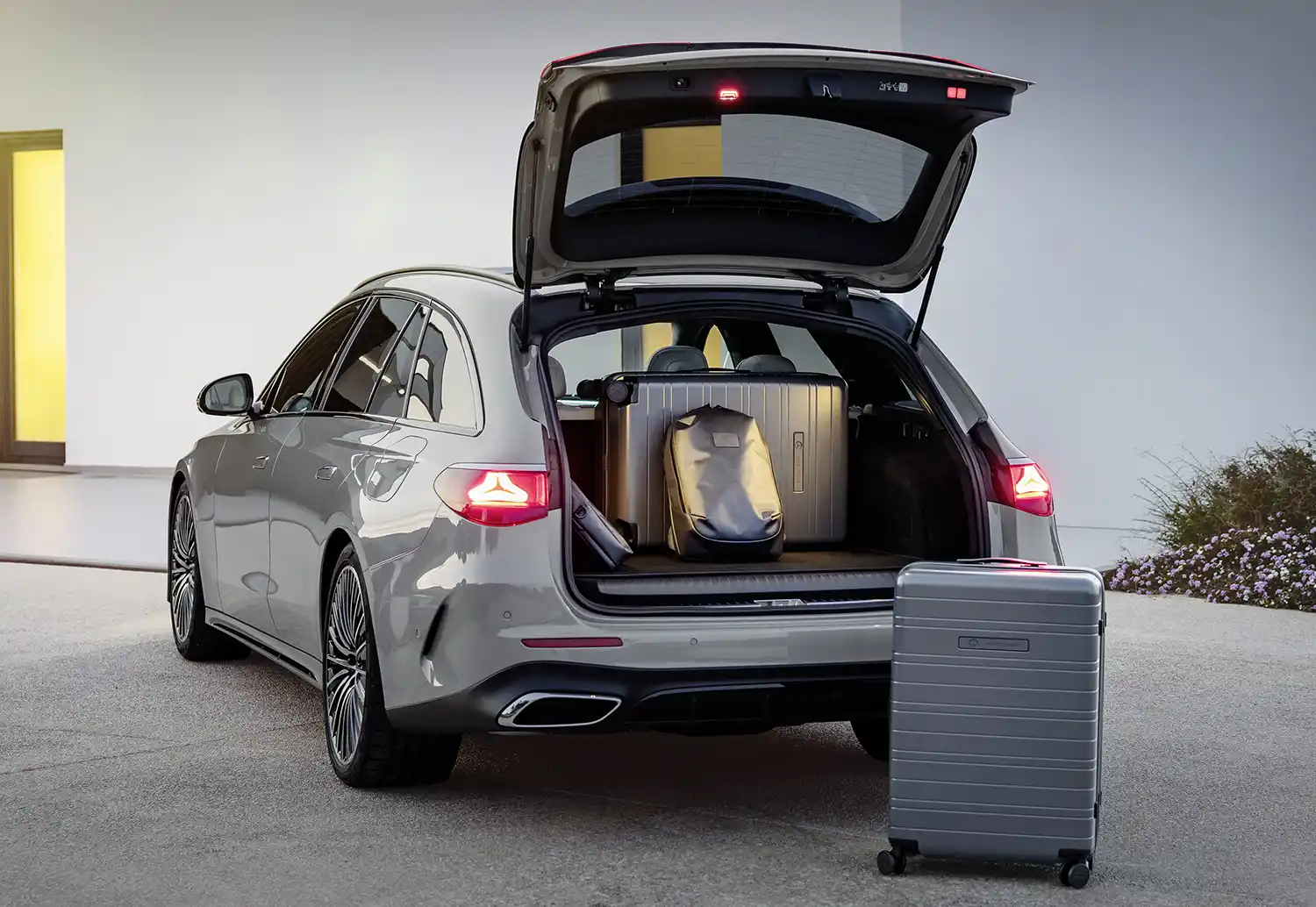
The characteristics as a towing vehicle
Whether caravans, trailers for leisure or work, or bicycle racks – the E-Class Estate has always been a proven towing and transport vehicle. The new generation will also score points with trailer towers. On the one hand, the high towing capacities of 2100/750 kilograms (braked/unbraked) contribute to this. They apply to all models, including those with plug-in hybrid drive. On the other hand, numerous practical functions such as the optional Trailer Manoeuvring Assist and the Trailer Mode in the MBUX system make manoeuvring easier. The tongue weight is 84 kilograms – so the carrying of e-bikes is allowed.
The optional trailer hitch can be folded in and out fully electrically. Operation is fully electric via the button in the tailgate or via the central display. As soon as the button light goes out, the hitch is correctly engaged and ready for use.
In combination with the trailer hitch, the Estate is equipped with ESP® trailer stabilisation as standard. The safety system can intervene automatically in critical situations when driving with a trailer. The vehicle recognises the trailer automatically as soon as the electrical connector plug is connected. The ESP® stabilisation functions are automatically active from a speed of 65 km/h. If undesired weaving is detected, the trailer stabilisation system actively counteracts this with the help of wheel-specific, reciprocal braking interventions. In most cases, this is already enough to reduce dangerous vibrations. If necessary, the system reduces the vehicle speed as well: for this, the engine torque is reduced and the vehicle is braked via all four wheels.
Adjust speed limits: Trailer mode in MBUX
In a menu on the central display, the trailer type can be selected and the maximum permitted speed can be specified. This allows the vehicle to adapt the Speed Limit Assist functions for trailer operation.
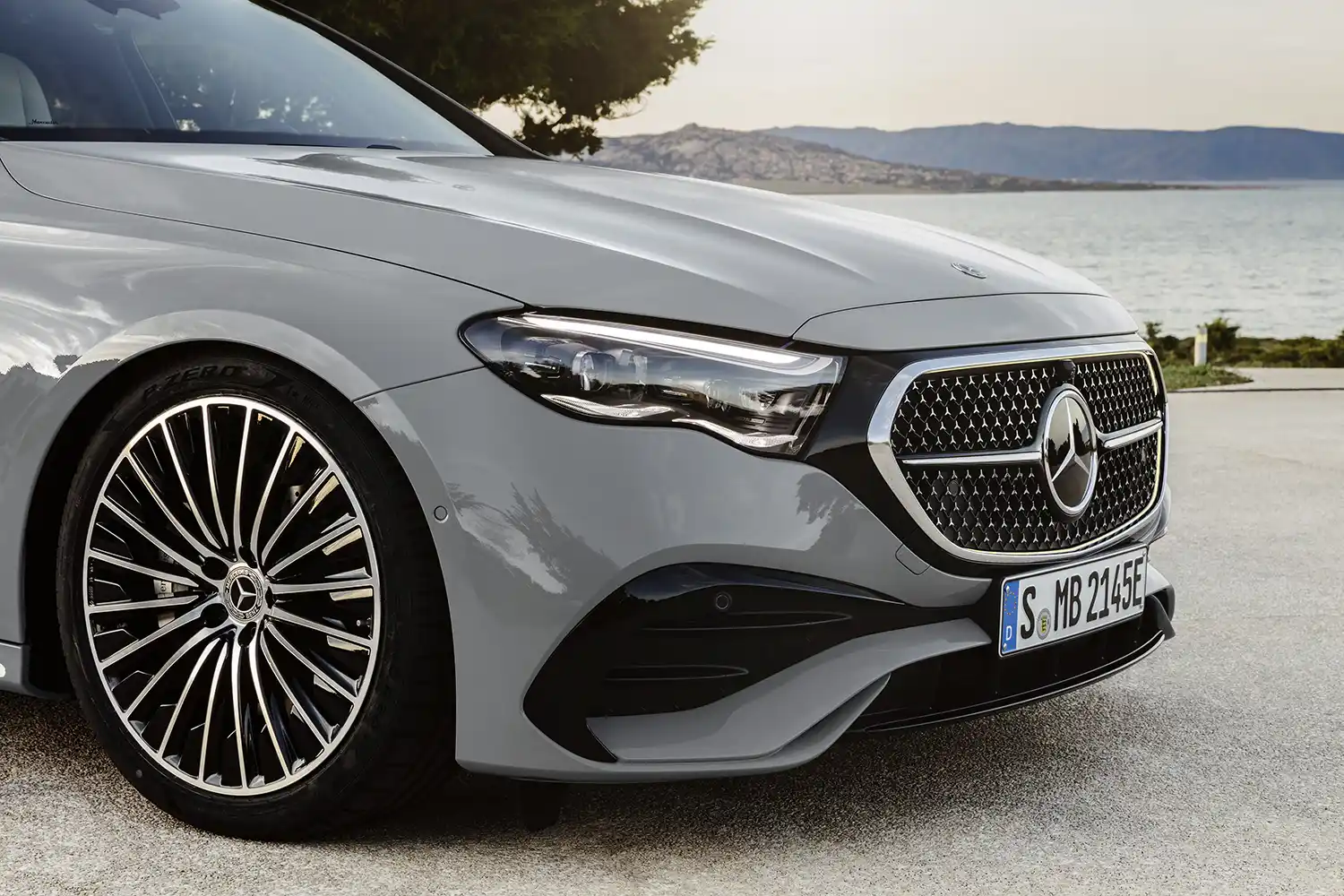
Depending on the market, the practical trailer route planner also takes into account restrictions for driving with trailers when navigating and avoids narrow roads or city centres – if possible.
Manoeuvre more easily: Trailer Manoeuvring Assist (optional)
Trailer Manoeuvring Assist (360° camera additionally required) handles reverse manoeuvring confidently and smoothly – even in difficult situations. This means that trailer towers benefit from the assisted control. It automatically regulates the steering angle on the towing vehicle at low speeds.
Trailer Manoeuvring Assist is connected to MBUX and can be operated intuitively via its menu. At the beginning of the manoeuvring process, the user simply specifies the desired manoeuvre: a direction specification by entering the target articulation angle (max. 90°) or the function “Pull straight”. The driver can view the manoeuvring process from different camera perspectives. Dynamic guidelines make it easier to gauge the travel path, vehicle width and distances.
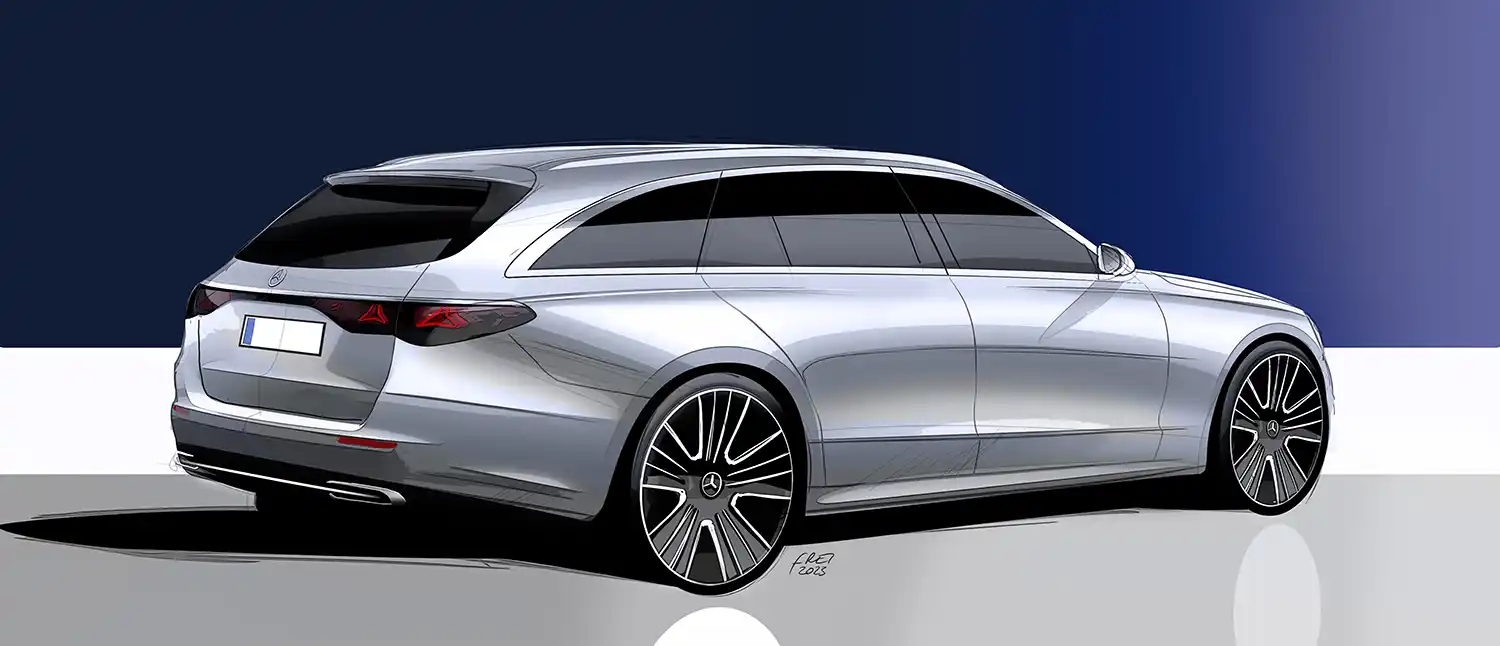
Aerodynamics and aeroacoustics
With a cd figure from 0.26, the new Mercedes-Benz E-Class Estate performs very well in its vehicle segment. It thus undercuts the very good value achieved by its facelifted predecessor (0.27). The fact that this high level has been maintained with only a slight spread between the individual variants is remarkable. This is because certain factors make aerodynamic performance more difficult: This includes, for example, the large wheel portfolio from 17 to 21 inches. At 2.38 m2 , the frontal area A of the new E-Class is slightly larger than that of its predecessor (2.35 m2 ).
Many computer simulations at an early stage increased the degree of maturity. This made fewer optimisation loops necessary in the wind tunnel. In close cooperation with their design colleagues, the aerodynamics team has specifically improved the E-Class Estate in numerous areas. Some details such as wheels with cladding inserts were adopted from the famously efficient Mercedes-EQ models. Here are the most important measures:
- Optimised contours: even including the tyres
- Innovative sealing of the front section: for the first time with side-sealing of the bonnet and an aero-lip in the radiator grille
- Wheels with claddings: so-called “aeroblinds”
- Special spoilers ahead of the front and rear wheels
- Flush, retractable door handles
- Underbody: new materials (2-component main floor with moulded-on sealing lips) and improved shape (ramp-shaped spoiler lips, aerodynamic cladding on suspension components)
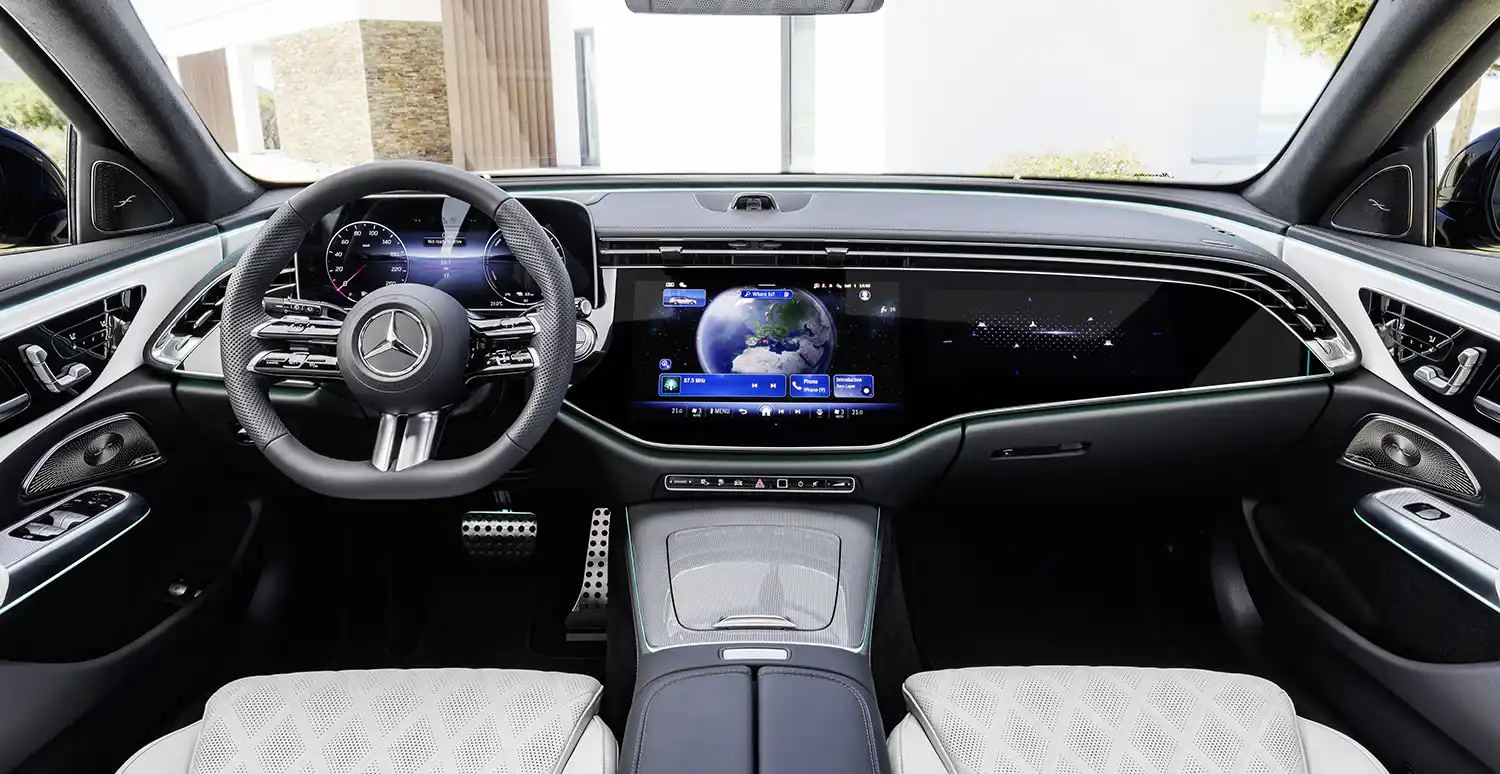
“Acoustic camera and acoustic holography” with almost 500 microphones
When it comes to aeroacoustic development, Mercedes-Benz always takes a dual approach: on the one hand, as little noise as possible should be generated at the source, i.e. when the air flows around the outer skin of the vehicle with all its mounted parts. And on the other hand, the quality of the sealing and sound insulation help to ensure that unavoidable wind noises are hardly perceptible in the interior, or not perceptible as disturbing.
During the early development phase, the engineering team began to configure the geometric dimensions of the A-pillar and the exterior mirrors, which are particularly relevant for noise generation, accordingly. Advanced development methods using flow simulations and noise measurements were combined when optimising shapes: For the latter, a special microphone array was used in the acoustic wind tunnel. The extensive interior measurements are also called “acoustic holography”. In this process, Mercedes-Benz uses 64 double microphones in the interior (hand array), which can locate problem areas in low-frequency ranges. Including the devices for outside measurements (“acoustic camera”), Mercedes-Benz uses almost 500 microphones.
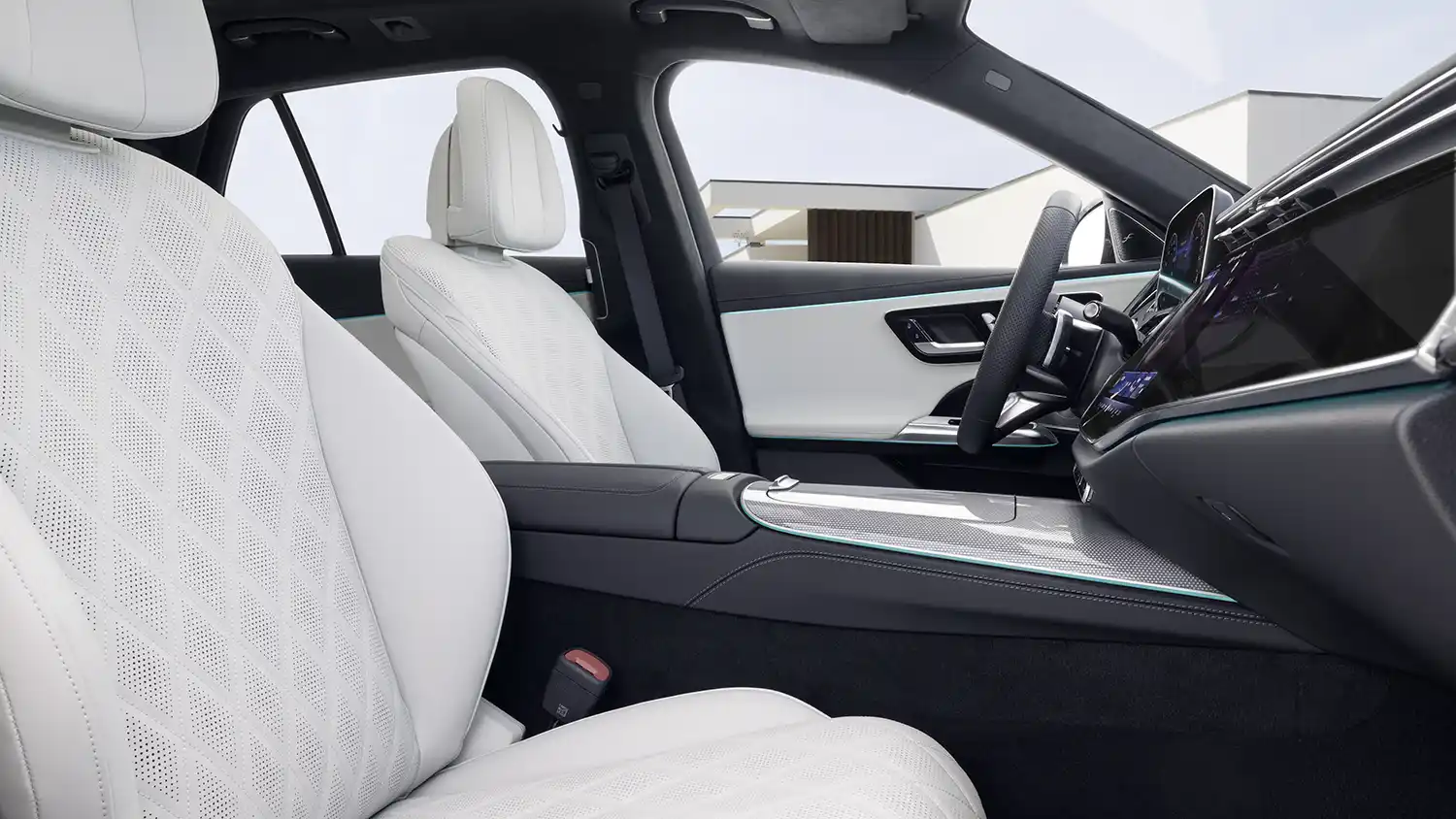
The high-frequency components of the wind noise were reduced by a variety of measures in the door seals, side windows and exterior mirrors. The structural rigidity of the doors was increased in the relevant areas. At very high driving speeds, this results in less wind noise. Cavities are foam-protected to improve the acoustic insulation in the body-in-white. This affects the structure of the cockpit cross-member and areas of the transmission tunnel and the A and C-pillars.
In the panoramic sliding sunroof, many detailed improvements were made to the wind deflector and by adding side wind deflectors to the glass roof. The result is better noise comfort and reduced draughts. In the tilt position, the glass panel is lowered depending on the vehicle speed. This also ensures pleasant interior acoustics and reduces actual aerodynamic drag.
The suspension
The agile handling of the new E-Class Estate is due in large part to precise guidance of the front wheels by four control arms each. At the rear axle, an optimised multi-link independent rear suspension with five links ensures excellent wheel control and excellent straight-line stability. At both axles, the springs and dampers are combined in a single strut and are not involved in wheel guidance tasks, therefore the suspension responds with corresponding sensitivity. The front subframe and rear axle carrier decouple the suspension and body from vibrations and noise, and are part of the sophisticated comfort concept.
All E-Class Estate models have single-chamber air suspension on the rear axle. This features a compact design, maintains ride comfort even with a full load on board and ensures that the vehicle remains horizontal even when laden. As standard, the mild hybrid models are equipped with an AGILITY CONTROL steel spring suspension. The rear-wheel-drive versions also have a selective damping system as standard.

The AIRMATIC air suspension system: All-round level control included
As an option, the new Mercedes-Benz E-Class Estate is available with all-round AIRMATIC air suspension with ADS+ continuously adjustable damping. The AIRMATIC suspension with air springs and adaptive ADS+ dampers responds very sensitively. The damping characteristics are controlled fully automatically for each individual wheel, and separately during rebound and compression. While driving, a sophisticated sensor system and algorithms set the dampers according to the quality of the road to ensure that, for example, driving over a bump with just one wheel is not transmitted to the entire axle and the interior.
The all-round level control is another feature of AIRMATIC. It keeps the ground clearance constant irrespective of the vehicle load, but also makes changes when needed. To reduce air resistance and thus fuel consumption, the vehicle level is automatically lowered by 15 millimetres from a speed of 120 km/h in the COMFORT driving mode. At the same time the vehicle’s centre of gravity is lowered, which improves driving stability.
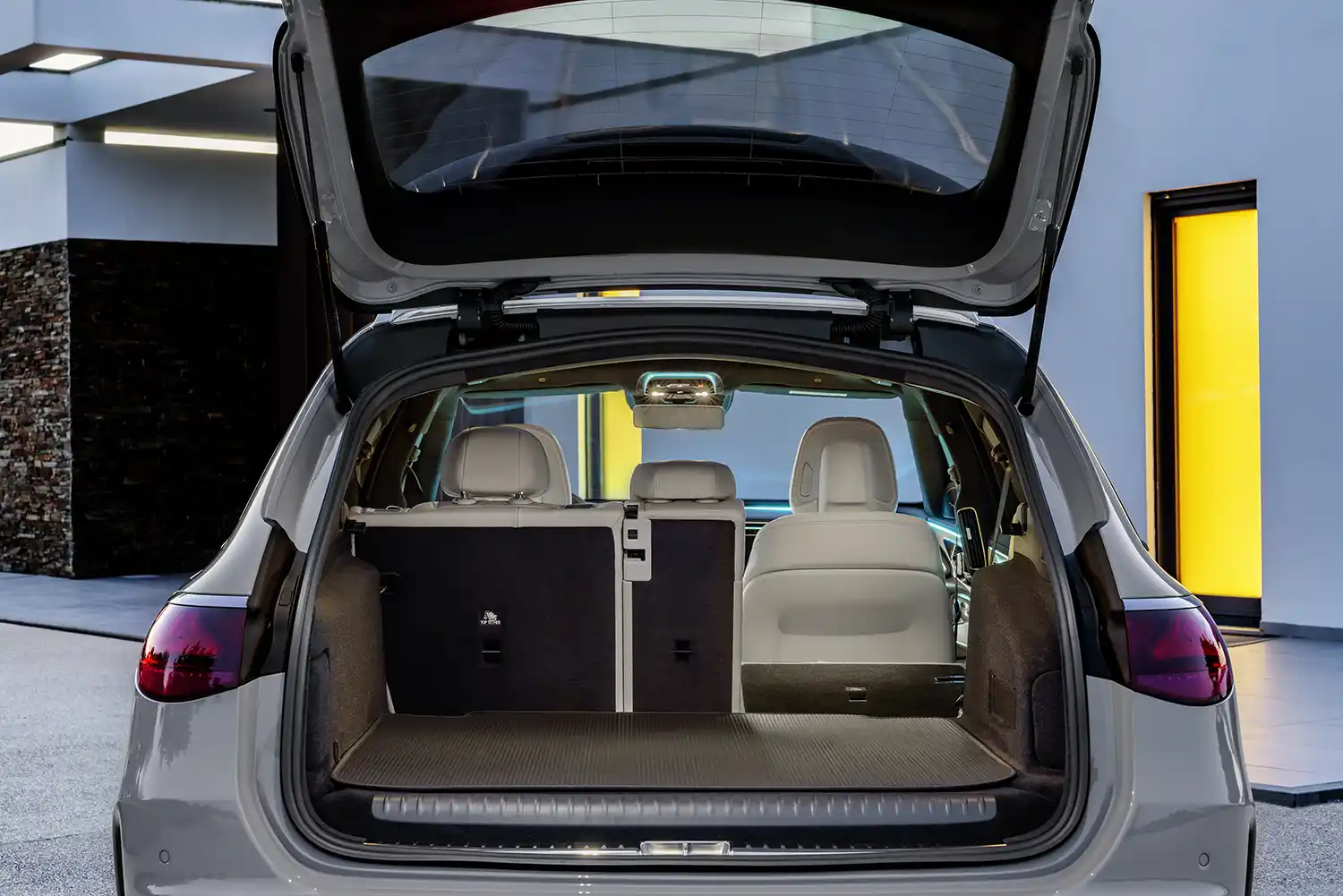
Drive system
Thanks to systematic electrification and intelligent downsizing, the new E-Class sets new standards in efficiency. A fourth-generation plug-in hybrid will already be available at market launch. Others will follow (for the plug-in hybrid model, see separate chapter).
The combustion engines are four and six-cylinder units from the current modular Mercedes-Benz engine family FAME (Family of Modular Engines). Accordingly, the engine range plays a major role in the flexibility of the international production network, with needs-based electrification.
In addition to turbocharging, both the diesel and petrol engines feature intelligent support from an integrated starter-generator (ISG). They are therefore mild hybrids. Thanks to a new battery, the power of the electric motor has been increased from 15 to 17 kW and the boost torque to 205 Nm.
The ISG uses a 48 volt on-board electrical system that ensures functions such as gliding, boosting or energy recovery, and makes significant fuel savings possible. The engines also start very rapidly and comfortably as a result, so that the start/stop function is almost as imperceptible to the driver as the transition from gliding with the engine switched off to strong acceleration under engine power. When idling, the intelligent interaction between the ISG and the combustion engine ensures outstandingly smooth running.
Petrol models: with many innovations compared to the preceding power units
The four-cylinder petrol engine (M 254) is initially available with 150 kW as the E200 – further output levels will follow. In the M 254, Mercedes-Benz has combined all the innovations of the FAME modular engine family in a single unit. They include NANOSLIDE® cylinder coating, CONICSHAPE® cylinder honing (trumpet honing) and the exhaust aftertreatment system positioned directly at the engine.
A top model with an electrified in-line six-cylinder will round off the engine range at the top end.
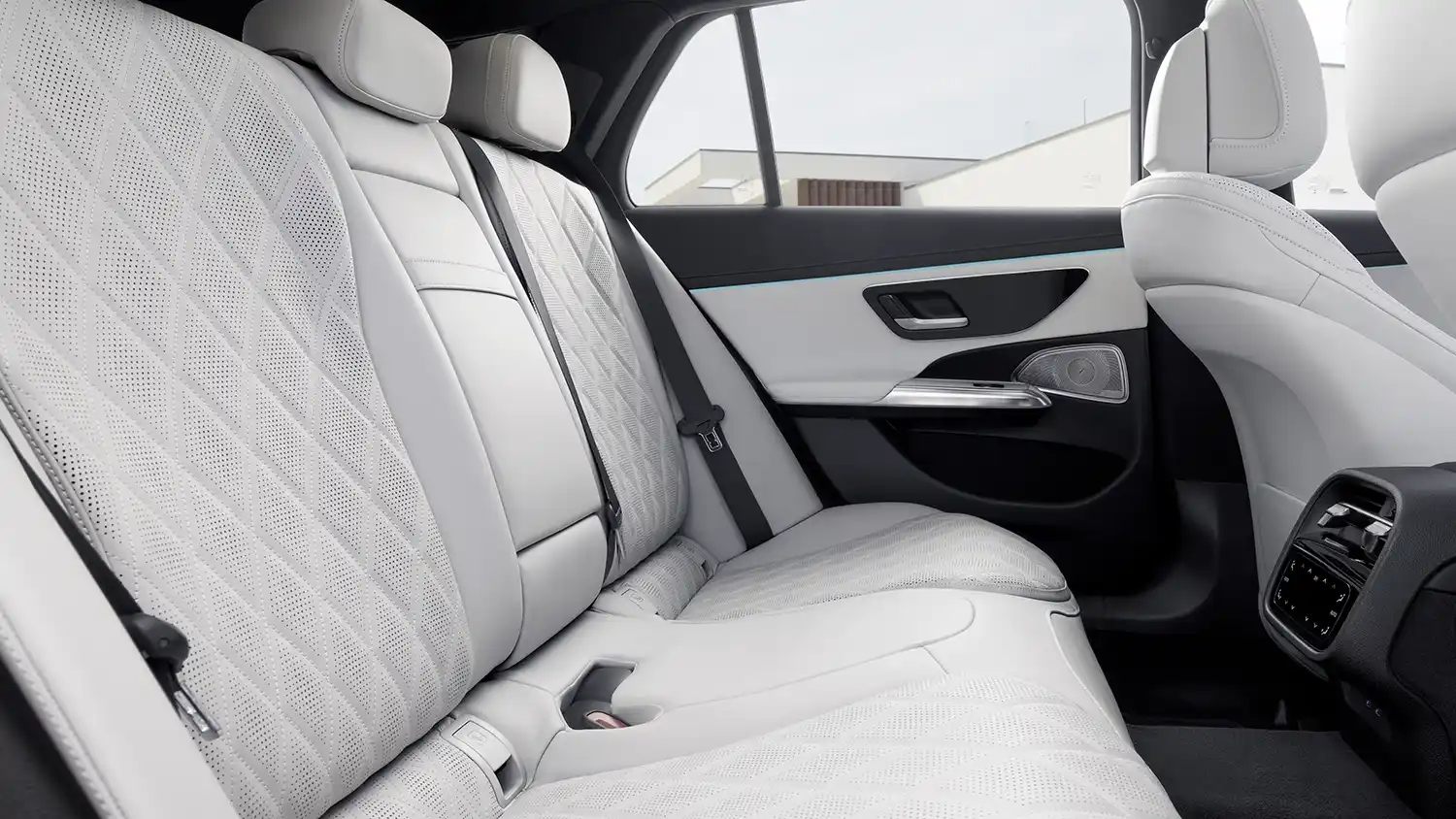
Diesel: current development level
The E220d is powered by the OM 654 M. The electrification also includes the use of an electric refrigerant compressor for the air conditioning system.
The OM654M in the E220d is charged by a single-stage turbocharger with variable turbine geometry and friction-optimised roller bearings. The turbocharger is tuned so that the engine responds quickly and delivers its power smoothly. The four-cylinder diesel is also up to date in terms of exhaust gas aftertreatment. Its components include:
- a close-coupled NOx storage catalytic converter for reducing nitrogen oxides
- a DPF (diesel particulate filter with special coating for reducing also the amount of nitrogen oxides)
- an SCR catalytic converter (selective catalytic reduction with metered injected quantity of AdBlue®) and
- an additional SCR catalytic converter in the vehicle’s underbody, with a separately metered injected quantity of AdBlue®
Transmission: automatic as standard
The 9G-TRONIC transmission has been further developed and is used in all E-Class models. The electric motor, power electronics and transmission cooler have now moved into or to the transmission. Previously required lines are eliminated, which offers advantages with regard to installation space and weight. In addition, the efficiency of the transmission has been increased. Amongst other things, the optimised interplay with the electric auxiliary oil pump reduces the delivery rate of the mechanical pump by 30 percent compared with the predecessor – good for efficiency. Furthermore, it uses a new generation of the fully integrated transmission control with multi-core processor and new design and connectivity technology. In addition to the increased computing power, the number of electric interfaces has been drastically reduced, and the weight of the transmission controls have been cut by 30 percent compared with the predecessor.
The driving assistance systems
The driving assistance systems with which the E-Class Estate is equipped as standard include ATTENTION ASSIST, Active Brake Assist, Active Lane Keeping Assist, Parking Package with reversing camera and Speed Limit Assist. The status and activity of the driving assistance systems are shown as a full-screen view in the Assistance mode of the driver’s display.
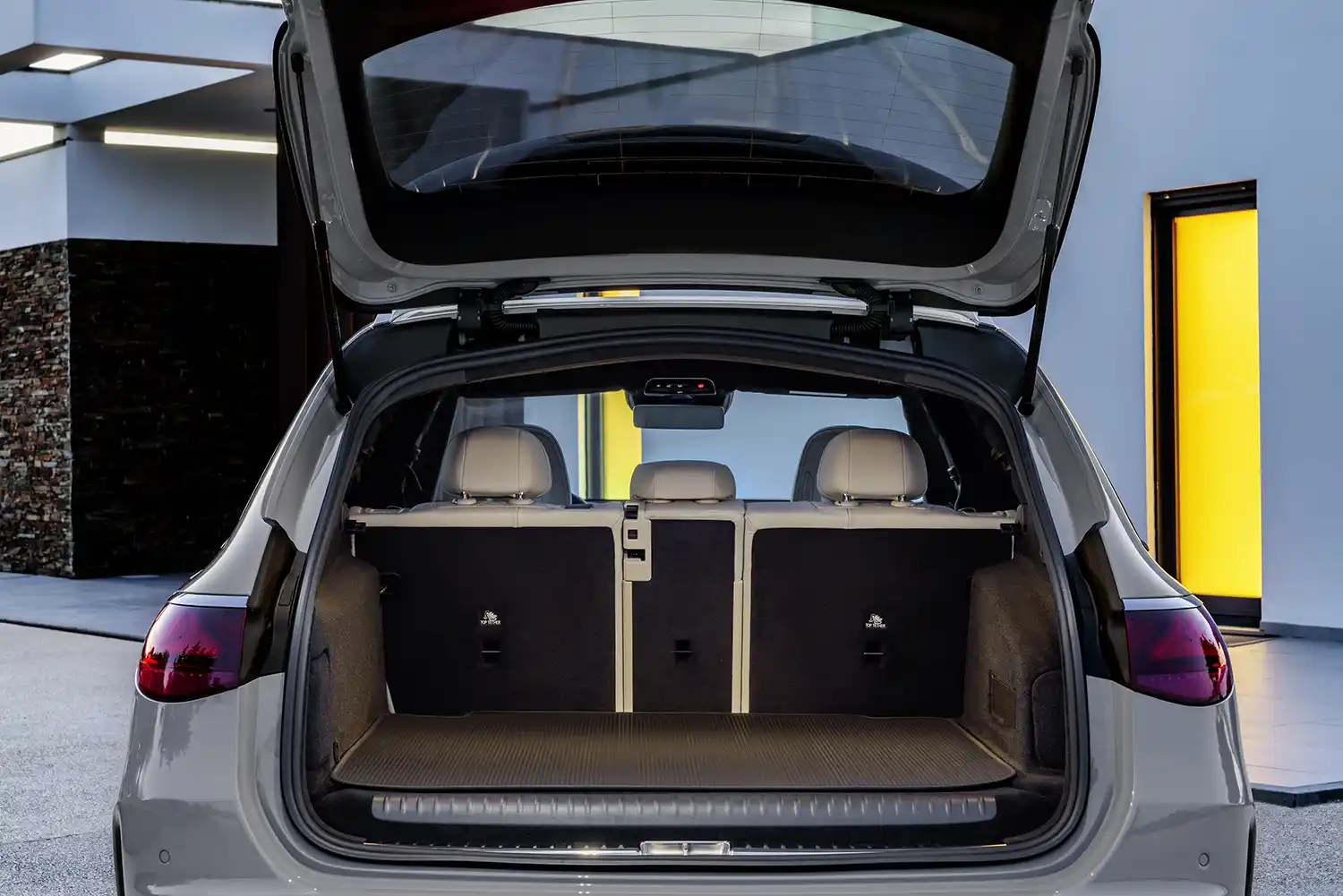
Active Distance Assist DISTRONIC is standard equipment In Western Europe. The system relieves the driver by regulating the speed to match that of slower vehicles ahead. The desired safety distance can be set in several increments. In an easy-to-understand way, the Get Started app in MBUX explains how Active Distance Assist DISTRONIC works.
With extended functionality: the Driving Assistance Plus package
The Driving Assistance Package Plus is available as an optional extra. Components include Active Steering Assist, which assists with lane-keeping. As previously on motorways, the Mercedes-Benz E-Class Estate can now also start off automatically in city traffic and on country roads after coming to a standstill. This is possible in a time window of 30 seconds when the hands are on the steering wheel. Another new feature: if Active Steering Assist is no longer available because the lane markings are not clearly visible, it signals this to the driver by vibrations in the steering wheel. As before, if Steering Assist is not available, the steering wheel symbol in the driver display also changes from green to grey.
Other features of this assistant include lane detection at low speeds additionally with 360° camera, very high availability and cornering performance on rural roads and improved lane centring on motorways. Depending on the situation, a driving position which is off the centre of the lane (e.g. formation of an emergency corridor, but also orientation via the edge of the carriageway on rural roads without centre markings) can be used.
The other components of the Driving Assistance Plus package:
- Active Distance Assist DISTRONIC offers more functions than the standard system. These include reaction to stationary vehicles, automatic restart and automatic speed resumption up to 210 km/h.
- The junction start-off function ensures additional safety when moving off at junctions with crossing traffic. The system uses intuitive arrows in the driver’s display to indicate from which direction cross-traffic is approaching. If the driver nevertheless attempts to move off, an audio-visual collision warning is triggered. The vehicle is prevented from moving off by automatically applying the brake. The driver can cancel this at any time by fully depressing the accelerator pedal.
- Active Lane Change Assist cooperatively assists the driver in changing to the adjacent lane. A lane change to the right or left is only assisted if the sensors detect that the adjacent lane is separated from the present lane by broken lane markings, and no other vehicles are detected in the relevant danger zone.
- Active Emergency Stop Assist brakes the vehicle to a standstill in its own lane if it recognises that the driver is no longer responding to the traffic situation for a longer period. If the E-Class Estate is travelling at less than 60 km/h, the assistant warns following traffic with the hazard warning lights. In addition, the doors unlock when the vehicle is stationary and the assistant calls for assistance via Mercedes-Benz Emergency Call.
- Active Brake Assist with cross-traffic function can use the onboard sensors to register whether there is a risk of collision with a vehicle ahead or crossing or oncoming traffic. If a collision is imminent, the system can warn the driver visually and audibly. If the driver’s braking is too weak, it is also possible to support the driver by increasing the braking torque according to the situation and to initiate emergency braking if there is no reaction from the driver.
- Evasive Steering Assist can assist the driver when seeking to avoid another road user detected by the system in a critical situation. In the new E-Class Estate, the system not only recognises stationary and crossing pedestrians, but now also takes account of pedestrians and vehicles alongside, as well as cyclists. The speed range is up to 110 km/h.
- From speeds above 60 km/h, Active Lane Keeping Assist uses a camera to detect when road markings or road edges are crossed, helping the driver to avoid leaving the driving lane unintentionally. If there is a risk of collision with detected road users in the adjacent lane, for example overtaking or oncoming vehicles, the system can also react with steering intervention and warnings.
- Active Blind Spot Assist can give a visual warning – and if the indicators are operated, also an audible warning – of potential side collisions at speeds exceeding around 10 km/h. If the driver ignores the warnings and still tries to change lanes, the system can take last-moment corrective action by one-sided braking intervention at speeds over 30 km/h. When the vehicle is stationary, the exit warning function can warn against exiting because a vehicle (or even a bicycle) is passing within the critical area.
- PRE-SAFE® PLUS can take action in the event of an imminent rear-end impact. The system warns the driver in the vehicle following behind by activating the rear hazard warning lights with increased frequency. In addition, the preventive PRE-SAFE® occupant protection measures, including the reversible belt tensioners, are triggered. If the vehicle is stationary, PRE-SAFE® PLUS locks the brakes. Reducing forward motion can significantly reduce the loads acting on occupants, including the risk of whiplash.
- Only a limited crumple zone is available in a side impact. PRE-SAFE® Impulse Side can move the affected front occupant away from the danger towards the middle of the vehicle even before the crash, as soon as the system detects that a side-on collision is immediately imminent. For this purpose, air chambers in the side bolsters of the front seat backrests inflate in fractions of a second.
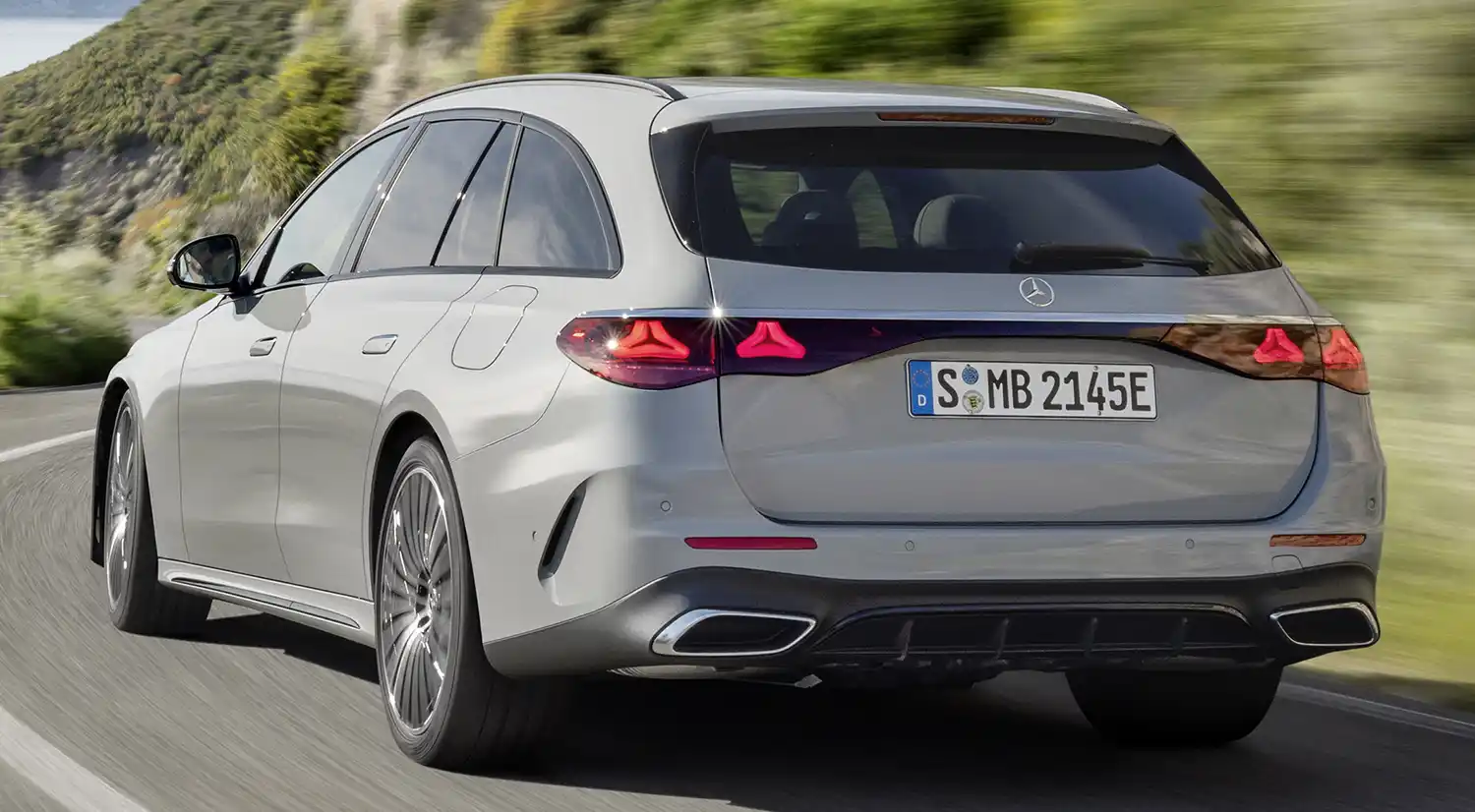
Passive safety
The safety concept of the E-Class Estate is based on an intelligently designed body with a particularly rigid passenger cell and specifically deformable crash structures. The restraint systems, e.g. seat belts and airbags, are specifically adapted to this. In the event of an accident, they can be activated in such a way that their protective effect for the occupants is adapted to the situation.
With the aid of numerous numerical simulations, the safety experts at Mercedes-Benz have designed the vehicle structure for a high level of occupant protection. For the aspects of the vehicle configuration that are relevant in an accident, they not only took account of the legal requirements and the criteria of consumer protection organisations; they also considered internal requirements and test criteria derived from real-life accident findings.
Modern restraint systems: protection for all passengers
In addition to driver and front passenger airbags, a knee airbag on the driver’s side is also standard. It can protect the legs from contact with the steering column or instrument panel in a severe frontal crash.
The standard windowbags can reduce the risk of head injuries – due to contact with the side window, for example. In the event of a serious side-on collision, the window airbag on the side of the impact extends from the A- to the C-pillar like a curtain over the front and rear side windows. If a rollover is detected, the window airbags can be activated on both sides. In addition to the head protection system, side airbags can also protect the thorax area in the event of a severe side impact – including on the outer rear seats as an option.
In addition, the vehicles are equipped with a centre airbag, depending on the country. This is integrated into the backrest of the driver’s seat towards the centre console. It can position itself between the driver and the front passenger in the event of a severe side impact, depending on the direction of the impact, the severity of the accident and the occupancy status. Pyrotechnic belt tensioners and force limiters are standard on all outer seats, as are seat belt adjusters.
The Mercedes-Benz E-Class Estate has i-Size child seat attachments as standard on the two outer seats in the second row. With two anchors each between the seat backrest and the seat cushion, corresponding child seats can be installed particularly quickly and securely. Top-tether attachment points on the rear of the rear seat backrests provide additional support. If a rear-facing child seat is placed in the front passenger seat, the vehicle can automatically deactivate the passenger airbag as required, depending on the market.
Warnings: if the belt is not worn and people and animals are forgotten
The European version of the E-Class Estate not only has a seat belt status indicator for the rear, but also a sophisticated seat belt warning system. This warns the driver if the seat belt is not fastened when the seat is occupied.
The occupancy reminder can help to indicate people or animals that may have been overlooked in the rear of the vehicle. It activates and deactivates itself automatically if prolonged opening of a rear door indicates that persons or animals have got in and are in the rear seats.
When the vehicle is switched off, the driver receives the text message “Do not leave persons or animals behind” on the driver’s display if the system has activated automatically beforehand. The customer has the option to deactivate the system. An indicator light shows the status of the system.
PRE-SAFE® system: precautionary protection
In Europe, the PRE-SAFE® preventive occupant protection system is standard in the E-Class Estate as part of the Advanced Package. This includes the known precautionary measures in the event of a recognised impending accident, including pre-conditioning of the hearing with PRE-SAFE® Sound.
In conjunction with the Driving Assistance Plus package, PRE-SAFE® Impulse Side forms a kind of virtual crumple zone on the vehicle sides. As there is only a limited crumple zone available in a severe side impact, PRE-SAFE® Impulse Side can move the affected driver or front passenger away from the danger towards the centre of the vehicle even before the crash. To do this, as soon as the system detects that a side collision is imminent, air chambers in the side bolsters of the front seat backrests are inflated in fractions of a second before the collision.
